
Exhibit 99.1
James Hardie Industries N.V.
ABRN 097 829 895
Results for Announcement to the Market
3rd Quarter Ended 31 December 2003
Net Sales |
up |
23% |
to |
US$237.5M |
||||
Operating Profit From Continuing Operations |
up |
89% |
to |
US$28.3M |
||||
Net Operating Profit including
Discontinued Operations |
up |
94% |
to |
US$30.1M |
Results for the 3rd Quarter and nine months ended 31 December 2003
Contents
| 1. | Media Release |
| 2. | Results At A Glance |
| 3. | Management’s Discussion and Analysis for 3rd Quarter and Year-To-Date |
| 4. | Consolidated Financial Statements |
| 5. | Management Presentation |
The above results documents comprise the information required by Rule 4.2A and the statement required by rule 4.2C.2.
The information contained in the above documents should be read in conjunction with the James Hardie 2003 Annual Report which can be found on the company wesite at www.jameshardie.com.
Incorporated in The Netherlands with corporate seat in Amsterdam. The liability of members is limited.
| media release1 |
| 12 February 2004 |
Analyst and Media enquiries, please contact Greg Baxter on Tel: 61 2 8274 5377
Mob: 0419 461 368 or Steve Ashe on Tel: 61 2 8274 5246 Mob: 0408 164 011 |
3rd Qtr Operating Profit Up 89% to US$28.3m
James Hardie today announced an 89% increase in 3rd quarter operating profit from continuing operations to US$28.3 million for the three months ended 31 December 2003.
For the nine months year-to-date, operating profit from continuing operations is up 56% to US$94.0 million.
Overall, third quarter net sales increased 23%, gross profit was up 22% and EBIT2 increased 36% to US$41.2 million.
The company’s major businesses all recorded significant improvements in 3rd quarter operating performance compared to the same period last year.
The USA Fibre Cement business continued to generate strong growth, lifting net sales 20% and EBIT2 18% compared to the same period last year.
EBIT2 increased 43% in Australia and New Zealand, and the Philippines business recorded another quarterly profit.
Basic earnings per share from continuing operations increased 88% for the quarter, from US 3.3 cents to US 6.2 cents.
Net operating profit including discontinued operations in the 3rd quarter was US$30.1 million. Year-to-date, net operating profit including discontinued operations is US$97.6 million, down slightly on the same period last year that included a profit of US$55.6 million related to the sale of Las Vegas land associated with our former Gypsum business.
3rd Quarter and Year-to-Date at a Glance – US$ Million
| Q3FY04 | Q3FY03 | %+\(-) | YTD FY04 | YTD FY03 | %+ (-) | |||||||||||||||||||
Net Sales |
237.5 | 192.6 | 23 | 730.6 | 589.3 | 24 | ||||||||||||||||||
Gross Profit |
87.5 | 71.6 | 22 | 269.2 | 213.7 | 26 | ||||||||||||||||||
EBIT2 |
41.2 | 30.2 | 36 | 137.4 | 100.9 | 36 | ||||||||||||||||||
Net Interest Expense |
(2.8 | ) | (12.4 | ) | (77 | ) | (7.5 | ) | (17.8 | ) | (58 | ) | ||||||||||||
Income Tax Expense |
(10.0 | ) | (2.8 | ) | 257 | (32.5 | ) | (22.8 | ) | 43 | ||||||||||||||
Operating Profit from continuing operations3 |
28.3 | 15.0 | 89 | 94.0 | 60.4 | 56 | ||||||||||||||||||
Net Operating Profit including discontinued
operations4 |
30.1 | 15.5 | 94 | 97.6 | 116.0 | (16 | ) | |||||||||||||||||
Unless otherwise stated, results are for continuing operations only and comparisons are of the 3rd quarter of the current
fiscal year versus the 3rd quarter of the prior fiscal year
Commentary
James Hardie’s CEO, Peter Macdonald said: “The third quarter results have cemented the strong performance of the first half and the growth momentum evident in the first nine months is continuing into the fourth quarter. We are on track for a solid and satisfactory full year result.
“In North America, we continued to win market share and delivered strong growth in revenues, volumes and profits, offsetting our further investment in growth initiatives which drove up costs.
“Demand for our interior and exterior range of products remains strong in both our emerging and established markets within North America and we expect to continue taking share from alternative materials.
“The broader outlook for housing in North America also remains positive,” Mr Macdonald said.
USA Fibre Cement – Continued Strong Growth
Net sales increased 20% to US$175.3 million in the 3rd quarter due to a 20% increase in sales volume to 358.3 million square feet. A one-off gain of US$3.8 million was included in net sales in the 3rd quarter last year. Excluding this, net sales were up 23% and average selling prices increased 2% to US$489 per thousand square feet.
In both the interior and exterior product markets and in our emerging and established markets, our products continued to take market share from alternative materials, helping to deliver good growth for the quarter.
The 2% increase in average selling prices largely reflects sales of higher-priced, differentiated products increasing as a proportion of total sales.
Strong top line growth helped lift EBIT 18% to US$44.6 million for the quarter. Excluding the one-off US$3.8 million gain in the prior year, EBIT was up 31%. The EBIT margin for the quarter was 25.4%.
During the quarter, we continued to ramp-up the recently-upgraded capacity at the Blandon, Pennsylvania and Waxahachie, Texas plants, as well as our new proprietary pre-finishing line at the Peru, Illinois plant which is used to paint our ColorPlus™ Collection of products.
Australia and New Zealand Fibre Cement – Stronger Operating Performance
Net sales increased 26% to US$50.7 million for the quarter due almost entirely to favourable currency translation. New housing and commercial activity in Australia were weaker compared to the same period a year ago, but housing renovations remained buoyant. In New Zealand, new housing activity remained healthy.
EBIT for the quarter was up 43% and the EBIT margin increased to 21.1%.
Philippines – Operating Profit
The Philippines business recorded another operating profit in the quarter as it continued to generate increased sales and lowered manufacturing costs.
| Media Release: James Hardie - 3rd Quarter and Nine Months Results FY04 | 2 |
Chile – Operating Profit
The business recorded another quarterly profit after sales more than trebled for the quarter, compared to the same period a year ago.
USA Hardie® Pipe – Strong Growth and Manufacturing Efficiencies
The business continued to improve its manufacturing performance and deliver top line growth as it further penetrated its target market in Florida, USA. However, prices remain low and manufacturing costs are still higher than our targets, resulting in the business incurring a loss for the quarter.
Europe
Our expansion into Europe is tracking in line with expectations since the business became operational in the first quarter. We continued to add distribution outlets in the U.K. and France and expand the business’s sales and marketing operations during the quarter, helping to build awareness among distributors, builders and contractors.
Artisan Roofing
The first commercial sales of our new generation of fibre cement roofing products were made during the quarter, and production trials and commissioning work at the pilot plant in California are continuing.
Outlook
In North America, the outlook for housing construction and repair and remodelling activity remains positive. Mortgage rates are low, house prices are strong, building permits are up and there are low inventories of new homes for sale.
The US-based National Association of Home Builders reports that builders remain upbeat about the strength of the market in 2004 and, while projecting a small decline in housing starts in 2004, says “there is a possibility that housing starts in 2004 could surpass the excellent performance of 2003”.
The company expects its North American business to continue to win market share in its interior and exterior product categories, and in both its established and emerging markets.
In Australia and New Zealand, the renovations segment is expected to remain relatively healthy over the short term, but new housing activity in Australia is expected to be softer over the same period. Market share gains are expected for differentiated products such as Linea® weatherboards. Profitability is expected to further improve due to increased sales of higher-priced differentiated products and manufacturing efficiency gains.
In the Philippines, domestic building and construction activity is expected to be stronger in the fourth quarter due to increased government spending. Further market penetration against plywood and more manufacturing cost savings are expected. Export sales should also be stronger with signs that economic conditions in the region are becoming more favourable.
In Chile, increased penetration and share growth is expected from stronger domestic construction activity and an increased awareness of the business’s expanded product range among builders, distributors and contractors.
The USA Hardie® Pipe business is continuing to improve operating efficiency, reduce costs and increase production to meet growing demand.
| Media Release: James Hardie - 3rd Quarter and Nine Months Results FY04 | 3 |
In Europe, further market penetration is expected as the business continues to build awareness of its products among builders, contractors and distributors.
Overall, there is no sign of any near-term threat to satisfactory results for the full year, and the strong growth momentum evident during the first nine months is continuing.
We are comfortable that operating profit from continuing operations for the 2004 fiscal year will fall within the current range of analysts’ forecasts of between US$122 million and US$134 million*.
Ends.
Media/Analysts call:
Greg Baxter
Executive Vice President
Telephone: 61 2 8274 5377
Mobile: 0419 461 368
Email: [email protected]
Or
Steve Ashe
Vice President Investor Relations
Telephone: 61 2 8274 5246
Mobile: 0408 164 011
Email: [email protected]
Facsimile: 61 2 8274 5218
The release and the accompanying MD&As and management presentation, along with the audio webcast of the presentation, are available from the Investor Relations section of the company website at www.jameshardie.com
| Media Release: James Hardie - 3rd Quarter and Nine Months Results FY04 | 4 |
Notes
| 1. | This media release forms part of a package of information about the company’s results. It should be read in conjunction with the other parts of this package, including Management’s Discussion and Analysis (MD&A), a Management Presentation, a Financial Report and a Results at a Glance document. |
| 2. | EBIT is defined as operating income. EBIT margin is defined as EBIT as a percentage of our net sales. We believe EBIT and EBIT margin to be relevant and useful information as these are the primary measures used by our management to measure the operating profit or loss of our business. EBIT is one of several metrics used by our management to measure the cash generated from our operations, excluding the operating cash requirement of our interest and income taxes. Additionally, EBIT is believed to be a primary measure and terminology used by our Australian investors. EBIT and EBIT margin should be considered in addition to, but not as a substitute for, other measures of financial performance reported in accordance with accounting principles generally accepted in the United States of America. EBIT and EBIT margin, as we have defined them, may not be comparable to similarly titled measures reported by other companies. |
| The use of EBIT and EBIT margins in this document are equivalent to the US GAAP measures of operating income and operating income margin. |
| 3. | Operating profit from continuing operations is equivalent to the US GAAP measure of income from continuing operations. |
| 4. | Net operating profit including discontinued operations is equivalent to the US GAAP measure of net income. |
Disclaimer
This media release contains forward-looking statements. Words such as
“believe,” “anticipate,” “plan,” “expect,” “intend,” “target,”
“estimate,” “project,” “predict,” “forecast,” “guideline,” “should,”
“aim” and similar expressions are intended to identify forward-looking
statements but are not the exclusive means of identifying such statements.
Forward-looking statements involve inherent risks and uncertainties. We
caution you that a number of important factors could cause actual results to
differ materially from the plans, objectives, expectations, estimates and
intentions expressed in such forward-looking statements. These factors,
which are further discussed in our reports submitted to the Securities and
Exchange Commission on Forms 20-F and 6-K and in our other filings, include
but are not limited to: competition and product pricing in the markets in
which we operate; general economic and market conditions; compliance with,
and possible changes in, environmental and health and safety laws;
dependence on cyclical construction markets; the supply and cost of raw
materials; our reliance on a small number of product distributors; the
consequences of product failures or defects; exposure to environmental,
asbestos or other legal proceedings; and risks of conducting business
internationally. We caution you that the foregoing list of factors is not
exclusive and that other risks and uncertainties may cause actual results to
differ materially from those contained in forward-looking statements.
Forward-looking statements speak only as of the date they are made.
| Media Release: James Hardie - 3rd Quarter and Nine Months Results FY04 | 5 |
Results at a Glance
3rd Quarter and Year-to-Date – 31 December 2003
| 3rd QTR FY04 | YTD FY04 | |||||||||||||||||||||||||||||||
James Hardie |
||||||||||||||||||||||||||||||||
| Net Sales | Up | 23 | % | to | US$237.5 | Up | 24 | % | to | US$730.6 | ||||||||||||||||||||||
| EBIT2 | Up | 36 | % | to | US$ 41.2 | Up | 36 | % | to | US$137.4 | ||||||||||||||||||||||
| Operating Profit3 | Up | 89 | % | to | US$ 28.3 | Up | 56 | % | to | US$ 94.0 | ||||||||||||||||||||||
| Net Operating Profit1,4 | Up | 94 | % | to | US$ 30.1 | Down | 16 | % | to | US$ 97.6 | ||||||||||||||||||||||
| EBIT Margin2 | Up | 1.6pts | to | 17.3 | % | Up | 1.6pts | to | 18.8 | % | ||||||||||||||||||||||
USA Fibre Cement |
||||||||||||||||||||||||||||||||
| Net Sales6 | Up | 23 | % | to | US$175.3 | Up | 22 | % | to | US$553.5 | ||||||||||||||||||||||
| EBIT2,6 | Up | 31 | % | to | US$ 44.6 | Up | 30 | % | to | US$152.4 | ||||||||||||||||||||||
| EBIT Margin2,6 | Up | 2.2pts | to | 25.4 | % | Up | 1.6pts | to | 27.5 | % | ||||||||||||||||||||||
| Volume | Up | 20 | % | to | 358.3mmsf | Up | 16 | % | to | 1136.3mmsf | ||||||||||||||||||||||
Asia Pacific Fibre Cement |
||||||||||||||||||||||||||||||||
| Net Sales | Up | 26 | % | to | US$ 55.9 | Up | 24 | % | to | US$160.8 | ||||||||||||||||||||||
| EBIT2 | Up | 55 | % | to | US$ 11.3 | Up | 28 | % | to | US$ 29.3 | ||||||||||||||||||||||
| EBIT Margin2 | Up | 3.8pts | to | 20.2 | % | Up | 0.6pt | to | 18.2 | % | ||||||||||||||||||||||
| Volume | Up | 5 | % | to | 98.3mmsf | Up | 9 | % | to | 301.0mmsf | ||||||||||||||||||||||
Key Ratios |
||||||||||||||||||||||||||||||||
| Earnings Per Share (Basic) | 21.0 cents | |||||||||||||||||||||||||||||||
EBIT Margin2 |
18.8 | % | ||||||||||||||||||||||||||||||
Return on Shareholders Funds1, 5 |
28.7 | % | ||||||||||||||||||||||||||||||
Return on Capital Employed5 |
26.2 | % | ||||||||||||||||||||||||||||||
Gearing |
22.9 | % | ||||||||||||||||||||||||||||||
Net Interest Cover (EBIT2 / Net interest expense) |
18.3x | |||||||||||||||||||||||||||||||
All comparisons are against the 3rd quarter or first nine months of the previous fiscal year. All dollar amounts are in US$ millions. Results are for continuing businesses only unless otherwise stated. Note: This document should be read in conjunction with other 3rd quarter and nine month results materials including a Media Release, a Management’s Discussion and Analysis, a Management Presentation and a Financial Report.
| 1 | Includes discontinued operations. | |
| 2 | EBIT is defined as operating income. EBIT margin is defined as EBIT as a percentage of our net sales. We believe EBIT and EBIT margin to be relevant and useful information as these are the primary measures used by our management to measure the operating profit or loss of our business. EBIT is one of several metrics used by our management to measure the cash generated from our operations, excluding the operating cash requirement of our interest and income taxes. Additionally, EBIT is believed to be a primary measure and terminology used by our Australian investors. EBIT and EBIT margin should be considered in addition to, but not as a substitute for, other measures of financial performance reported in accordance with accounting principles generally accepted in the United States of America. EBIT and EBIT margin, as we have defined them, may not be comparable to similarly titled measures reported by other companies. | |
| 3 | Operating profit from continuing operations is equivalent to the US GAAP measure of income from continuing operations. | |
| 4 | Net operating profit including discontinued operations is equivalent to the US GAAP measure of net income. | |
| 5 | Annualised. | |
| 6 | For the 3rd quarter, excluding a US$3.8 million rebate add-back in prior year revenue. Including the add-back, net sales increased 20%, EBIT was up 18% and the EBIT margin decreased 0.4 percentage points. |
Management’s Discussion and Analysis1
| 12 February 2004 |
Analyst and media enquiries, please contact Greg Baxter on Tel: 61 2 8274 5377
Mobile: 0419 461 368 or Steve Ashe on Tel: 61 2 8274 5246 Mobile: 0408 164 011 |
James Hardie Industries N.V.
Results for the 3rd Quarter Ended 31 December 2003
| USGAAP - US$ Millions | Three Months Ended 31 December | ||||||||||||
| FY 2004 | FY 2003 | % Change | |||||||||||
Net Sales |
|||||||||||||
USA Fibre Cement |
$ | 175.3 | $ | 146.3 | 20 | ||||||||
Asia Pacific Fibre Cement |
55.9 | 44.4 | 26 | ||||||||||
Other Fibre Cement |
6.3 | 1.9 | 232 | ||||||||||
Total Net Sales |
237.5 | 192.6 | 23 | ||||||||||
Net Sales |
$ | 237.5 | $ | 192.6 | 23 | ||||||||
Cost of goods sold |
(150.0 | ) | (121.0 | ) | 24 | ||||||||
Gross profit |
87.5 | 71.6 | 22 | ||||||||||
Selling General & Administrative expenses |
(40.6 | ) | (37.6 | ) | 8 | ||||||||
Research and Development expenses |
(5.7 | ) | (4.8 | ) | 19 | ||||||||
Restructuring and other operating expenses |
— | 1.0 | (100 | ) | |||||||||
EBIT 2 |
41.2 | 30.2 | 36 | ||||||||||
Net interest expense |
(2.8 | ) | (12.4 | ) | (77 | ) | |||||||
Other expense, net |
(0.1 | ) | — | — | |||||||||
Operating profit from continuing operations before income taxes 3 |
38.3 | 17.8 | 115 | ||||||||||
Income tax expense |
(10.0 | ) | (2.8 | ) | 257 | ||||||||
Operating Profit From Continuing Operations 4 |
$ | 28.3 | $ | 15.0 | 89 | ||||||||
Net Operating Profit Including Discontinued Operations 5 |
$ | 30.1 | $ | 15.5 | 94 | ||||||||
Tax rate |
26.1 | % | 15.7 | % | |||||||||
Volume (mmsf) |
|||||||||||||
USA Fibre Cement |
358.3 | 298.2 | 20 | ||||||||||
Asia Pacific Fibre Cement |
98.3 | 93.4 | 5 | ||||||||||
Average sales price per unit (per msf) |
|||||||||||||
| USA Fibre Cement | US$489 | US$491 | — | ||||||||||
Asia Pacific Fibre Cement |
A$800 | A$850 | (6 | ) | |||||||||
Unless otherwise stated, results are for continuing operations only and comparisons are of the 3rd
quarter of the current fiscal year versus the 3rd quarter of the prior fiscal year.
Total Net Sales
Total net sales increased 23% compared to the same quarter of the previous year, from US$192.6 million to US$237.5 million.
Net sales from USA Fibre Cement increased 20% from US$146.3 million to US$175.3 million due to continued strong growth in sales volumes.
Net sales from Asia Pacific Fibre Cement increased 26% from US$44.4 million to US$55.9 million due mainly to favourable exchange differences.
Net sales from Other Fibre Cement increased 232% from US$1.9 million to US$6.3 million as the Chilean flat sheet business and the USA-based Hardie® Pipe business continued to grow.
USA Fibre Cement
Net sales increased 20% from US$146.3 million to US$175.3 million, but were actually 23% higher after taking into account a one-off gain in the same quarter of the prior year that did not recur this quarter. This gain in the prior period was US$3.8 and was realised because sales rebate costs were lower than had been estimated.
Sales volume increased 20% from 298.2 million square feet to 358.3 million square feet, due to strong growth in primary demand for fibre cement and a favourable housing construction market.
Residential housing activity remained solid during the quarter in response to continued strong demand, fuelled by historically low interest rates, a recovering domestic economy and strong house prices.
In both the interior and exterior product markets and in our emerging and established markets, our products continued to take market share from alternative materials, mainly wood-based and vinyl siding, helping to deliver strong growth for the quarter.
The average net selling price showed a marginal decrease for the quarter, but was actually 2% higher after taking into account the one-off gain in the same quarter last year. The increase in the average selling price was due to an increased proportion of sales of higher-priced, differentiated products and a price increase in some regions implemented in the first quarter of this fiscal year.
In the exterior products market, there was continued strong growth in sales of higher-priced, differentiated products such as vented soffits, Heritage® panels, the ColorPlus™ Collection of pre-painted siding and Harditrim® XLD™ planks.
In the interior products market, sales of our Hardibacker 500® half-inch backerboard again grew strongly as it further penetrated its target market, helping to lift our share of the interior cement board market.
During the quarter, we continued to ramp-up the recently upgraded Blandon, Pennsylvania plant acquired from Cemplank in December 2001, the 160 million square feet panel production line at our Waxahachie, Texas plant, as well as the new proprietary pre-finishing line at our Peru, Illinois plant. Also at our Peru, Illinois plant, we commenced construction of the new 160 million square feet trim line, which is expected to be completed in 2004.
The site for our new 300 million square feet green-field fibre cement plant, announced in the first quarter of this fiscal year, has been changed from Sacramento, California to Reno, Nevada. The decision to move the site was made following a reassessment of the attractiveness of the Sacramento site once certain cost advantages subsequently became available in Reno. The new site enables the servicing of rapidly growing demand in the west coast region of the United States, while enhancing the overall attractiveness of the project.
| James Hardie 3rd Quarter FY04 MD&A | 2 |
Asia Pacific Fibre Cement
Net sales for this segment increased 26% from US$44.4 million to US$55.9 million. Sales volume increased 5% from 93.4 million square feet to 98.3 million square feet.
Australia and New Zealand Fibre Cement
Net sales increased 26% from US$40.1 million to US$50.7 million. In Australian dollars, net sales decreased 1%.
The decrease in local currency net sales resulted from a 2% decrease in the average net selling price due to product mix changes in FRC Pipes, partly offset by a 1% increase in sales volume from 76.4 million square feet to 77.1 million square feet. The small increase in sales volume reflects stronger domestic demand in both Australia and New Zealand, partly offset by weaker export sales.
In Australia, both new residential housing and commercial activity were weaker compared to the same period last year. This was partly offset by the residential renovations segment which remained buoyant.
During the quarter, FRC Pipes was successful in tendering to supply storm drainage pipes for the Sydney Orbital road project. The project involves the supply of a significant volume of FRC pipes over the next year.
In New Zealand, new residential housing activity continued to be healthy and there was strong demand for soffits and weatherboards, including our Linea® range of weatherboards, which uses proprietary low density technology. Non-residential construction activity was stronger compared to the same period last year.
Philippines Fibre Cement
Net sales increased 21% from US$4.3 million to US$5.2 million. In local currency, net sales increased 27% due to a 26% increase in sales volume compared to the same quarter of the previous year, from 16.8 million square feet to 21.1 million square feet, and a slightly higher average net selling price.
The average selling price increased 1% compared to the same quarter of the previous year due to a minor change in the sales mix.
Other Fibre Cement
Chile Fibre Cement
Net sales increased 383% compared to the same period last year. In local currency, the increase was 282% as our Chilean business further penetrated the domestic flat sheet market.
Sales volume increased 168% compared to the same quarter last year. The average selling price was 42% higher due to increased exports sales and growth in sales of higher-priced, differentiated products.
Construction activity in Chile continued to strengthen during the quarter.
| James Hardie 3rd Quarter FY04 MD&A | 3 |
Hardie® Pipe
Our USA Hardie® Pipe business continued to penetrate the south-east market of the United States and improve its manufacturing efficiency.
Net sales increased 82% compared to the same period last year due to a 67% increase in sales volume and a 9% increase in the average net selling price. The product mix remained relatively unchanged with the focus remaining on the 12” to 36” diameter range of drainage pipes.
The business continued to improve its manufacturing performance during the quarter, reducing costs and increasing output, but manufacturing costs are still higher than our targets.
The competitive response to our entry into the south-east market remains intense.
Europe
The business continued to build awareness and sales among distributors, builders and contractors and penetrate its target markets, following its commencement in the first quarter of this fiscal year.
During the quarter, further distribution outlets were added in both the U.K. and France, and the business expanded its sales and marketing force.
Market response to our interior and exterior range of products has been favourable and the rate of penetration continues to be in line with our expectations.
Artisan Roofing
In June 2003, we began trialling and commissioning our pilot roofing plant at Fontana, California. The pilot plant, which has a design capacity of 25 mmsf, was built to test our proprietary manufacturing technology and to provide product for market testing in Southern California.
The first commercial sales of Artisan® roofing were made during the quarter, and production trials and commissioning work are continuing. Interest in our roofing product within our targeted market is strong.
Gross Profit
Gross profit increased 22% from US$71.6 million to US$87.5 million due to improvements in all our major businesses. The gross profit margin decreased 0.4 of a percentage point to 36.8%.
USA Fibre Cement gross profit increased 20% due to higher net sales, partly offset by an increase in unit cost of sales. The higher unit cost of sales resulted primarily from increased sales of higher-priced, differentiated products, higher pulp costs and the ramp-up of the new manufacturing lines at the Blandon, Pennsylvania; Waxahachie, Texas; and Peru, Illinois plants. The gross profit margin decreased 0.1 of a percentage point.
Asia Pacific Fibre Cement gross profit increased 24% following improvements from Australia and New Zealand Fibre Cement and Philippines Fibre Cement. The improved result for Australia and New Zealand was due to a favourable foreign exchange difference. In the Philippines, increased sales and reduced manufacturing costs resulted in the stronger gross profit performance. The Asia Pacific Fibre Cement gross profit margin decreased 2.4 percentage points mainly due to an increase in manufacturing costs as a percentage of sales.
| James Hardie 3rd Quarter FY04 MD&A | 4 |
Selling, General and Administrative (SG&A) Expenses
SG&A expenses increased 8% compared to the same quarter last year, from US$37.6 million to US$40.6 million. The increase in SG&A expenses was due mainly to sales and marketing expenses associated with growth initiatives in the USA. However, as a percentage of sales, SG&A expenses were 2.4 percentage points lower, at 17.1%.
Research and Development Expenses
Research and development includes costs associated with “core” research projects that are aimed at benefiting all fibre cement business units. These costs are recorded in the Research and Development segment rather than being attributed to individual business units. These costs increased 33% for the quarter to US$3.6 million.
Other research and development costs associated with commercialisation projects in business units are included in the business related unit segment results. In total, these costs were flat at US$2.1 million.
EBIT2
EBIT increased 36% from US$30.2 million to US$41.2 million. The EBIT margin increased 1.6 percentage points to 17.3%.
USA Fibre Cement EBIT increased 18% from US$37.8 million to US$44.6 million. The increase was due to strong growth in net sales, partly offset by an increase in unit cost of sales and SG&A expenses. The EBIT margin decreased 0.4 of a percentage point to 25.4%. Excluding the gain of US$3.8 million recorded in the same period of the previous year related to the company rebate program, EBIT increased 31% and the EBIT margin increased 2.2 percentage points.
Asia Pacific Fibre Cement EBIT increased 55% from US$7.3 million to US$11.3 million. The EBIT margin increased 3.8 percentage points to 20.2%.
Australia and New Zealand Fibre Cement EBIT increased 43% from US$7.5 million to US$10.7 million. In Australian dollars, EBIT increased 12%. The increase in EBIT in Australian dollars was primarily due to lower SG&A costs compared to the same period last year. The EBIT margin was 2.4 percentage points higher, at 21.1%.
Our Philippines business recorded another small operating profit for the quarter due to increased net sales and manufacturing cost savings.
The Chile Fibre Cement business recorded its second consecutive, albeit small operating profit following the business achieving breakeven in the first quarter of this fiscal year.
Despite continued volume growth, our USA Hardie® Pipe business incurred an operating loss for the quarter due to low prices and higher than targeted production costs.
Our European fibre cement business incurred a small operating loss as expected, following its commencement earlier this fiscal year.
| James Hardie 3rd Quarter FY04 MD&A | 5 |
General corporate costs decreased by US$2.0 million from US$8.3 million to US$6.3 million. Employee bonus plan expense and share based compensation expense each saw decreases during the quarter, accompanied by other reductions, totalling a US$3.0 million decrease. These decreases were partially offset by a $1.0 million gain from the settlement of a pulp hedge contract in the prior year that did not recur this year.
Net Interest Expense
Net interest expense decreased by US$9.6 million from US$12.4 million to US$2.8 million. In the prior year, we incurred a US$9.9 million make-whole payment from the early retirement of US$60 million of long-term debt. Interest expense decreased further by US$0.6 million due to lower average borrowings. These decreases in net interest expense were partially offset by a US$0.9 decrease in interest income due to lower average cash balances and lower interest rates compared to the same quarter in the prior year.
Income Tax Expense
Income tax expense increased by US$7.2 million from US$2.8 million to US$10.0 million, consistent with the increase in profit.
Operating Profit from Continuing Operations4
Income from continuing operations increased by 89% or US$13.3 million, from US$15.0 million for the third quarter of the previous year to US$28.3 million this quarter.
Discontinued Operations
Income from discontinued operations in the current period includes a favourable outcome from income tax issues related to our former Gypsum business, net of other wind-up costs of Gypsum and other discontinued businesses.
End.
| James Hardie 3rd Quarter FY04 MD&A | 6 |
Media/Analysts call:
Greg Baxter
Executive Vice President
Telephone: 61 2 8274 5377
Mobile: 0419 461 368
Email: [email protected]
Or
Steve Ashe
Vice President Investor Relations
Telephone: 61 2 8274 5246
Mobile: 0408 164 011
Email: [email protected]
Facsimile: 61 2 8274 5218
The MD&As and accompanying release and management presentation, along with an audio webcast of the presentation are available at www.jameshardie.com
Notes
1. This Management’s Discussion and Analysis document forms part of a
package of information about the company’s results. It should be read in
conjunction with the other parts of this package, including a Media Release,
a Management Presentation, a Financial Report and a Results at a Glance
document.
2. EBIT is defined as operating income. EBIT margin is defined as EBIT as a percentage of our net sales. We believe EBIT and EBIT margin to be relevant and useful information as these are the primary measures used by our management to measure the operating profit or loss of our business. EBIT is one of several metrics used by our management to measure the cash generated from our operations, excluding the operating cash requirement of our interest and income taxes. Additionally, EBIT is believed to be a primary measure and terminology used by our Australian investors. EBIT and EBIT margin should be considered in addition to, but not as a substitute for, other measures of financial performance reported in accordance with accounting principles generally accepted in the United States of America. EBIT and EBIT margin, as we have defined them, may not be comparable to similarly titled measures reported by other companies.
The use of EBIT and EBIT margins in this document are equivalent to the US GAAP measures of operating income and operating income margin.
3. Operating profit from continuing operations before income taxes is equivalent to the US GAAP measure of income from continuing operations before income taxes.
4. Operating profit from continuing operations is equivalent to the US GAAP measure of income from continuing operations.
5. Net operating profit including discontinued operations is equivalent to the US GAAP measure of net income.
| James Hardie 3rd Quarter FY04 MD&A | 7 |
Disclaimer
This document contains forward-looking statements. Words such as “believe,”
“anticipate,” “plan,” “expect,” “intend,” “target,” “estimate,”
“project,” “predict,” “forecast,” “guideline,” “should,” “aim” and
similar expressions are intended to identify forward-looking statements but
are not the exclusive means of identifying such statements. Forward-looking
statements involve inherent risks and uncertainties. We caution you that a
number of important factors could cause actual results to differ materially
from the plans, objectives, expectations, estimates and intentions expressed
in such forward-looking statements. These factors, which are further
discussed in our reports submitted to the Securities and Exchange Commission
on Forms 20-F and 6-K and in our other filings, include but are not limited
to: competition and product pricing in the markets in which we operate;
general economic and market conditions; compliance with, and possible
changes in, environmental and health and safety laws; dependence on cyclical
construction markets; the supply and cost of raw materials; our reliance on
a small number of product distributors; the consequences of product failures
or defects; exposure to environmental, asbestos or other legal proceedings;
and risks of conducting business internationally. We caution you that the
foregoing list of factors is not exclusive and that other risks and
uncertainties may cause actual results to differ materially from those
contained in forward-looking statements. Forward-looking statements speak
only as of the date they are made.
| James Hardie 3rd Quarter FY04 MD&A | 8 |
Management’s Discussion and Analysis 1
| 12 February 2004 |
Analyst and media enquiries, please contact Greg Baxter on Tel: 61 2 8274 5377 Mobile: 0419 461 368 or Steve Ashe on Tel: 61 2 8274 5246 Mobile: 0408 164 011 |
James Hardie Industries N.V.
Results for the 9 Months Ended 31 December 2003
| USGAAP - US$ Millions | Nine Months Ended 31 December | ||||||||||||
| FY 2004 | FY 2003 | % Change | |||||||||||
Net Sales |
|||||||||||||
USA Fibre Cement |
$ | 553.5 | $ | 453.5 | 22 | ||||||||
Asia Pacific Fibre Cement |
160.8 | 130.0 | 24 | ||||||||||
Other Fibre Cement |
16.3 | 5.8 | 181 | ||||||||||
Total Net Sales |
730.6 | 589.3 | 24 | ||||||||||
Net Sales |
$ | 730.6 | $ | 589.3 | 24 | ||||||||
Cost of goods sold |
(461.4 | ) | (375.6 | ) | 23 | ||||||||
Gross profit |
269.2 | 213.7 | 26 | ||||||||||
Selling General & Administrative expenses |
(115.7 | ) | (101.2 | ) | 14 | ||||||||
Research and Development expenses |
(16.1 | ) | (12.6 | ) | 28 | ||||||||
Restructuring and other operating expenses |
— | 1.0 | (100 | ) | |||||||||
EBIT 2 |
137.4 | 100.9 | 36 | ||||||||||
Net interest expense |
(7.5 | ) | (17.8 | ) | (58 | ) | |||||||
Other (expense) income, net |
(3.4 | ) | 0.1 | — | |||||||||
Operating profit from continuing operations
before income taxes 3 |
126.5 | 83.2 | 52 | ||||||||||
Income tax expense |
(32.5 | ) | (22.8 | ) | 43 | ||||||||
Operating Profit From Continuing Operations 4 |
$ | 94.0 | $ | 60.4 | 56 | ||||||||
Net Operating Profit Including Discontinued
Operations 5 |
$ | 97.6 | $ | 116.0 | (16 | ) | |||||||
Tax rate |
25.7 | % | 27.4 | % | |||||||||
Volume (mmsf) |
|||||||||||||
USA Fibre Cement |
1,136.3 | 975.7 | 16 | ||||||||||
Asia Pacific Fibre Cement |
301.0 | 276.3 | 9 | ||||||||||
Average sales price per unit (per msf) |
|||||||||||||
| USA Fibre Cement | US$487 | US$465 | 5 | ||||||||||
Asia Pacific Fibre Cement |
A$797 | A$851 | (6 | ) | |||||||||
Unless otherwise stated, results are for continuing operations only and comparisons
are of the first nine months of the current fiscal year versus the first nine months of the prior fiscal year.
Total Net Sales
Total net sales increased 24% compared to the same period of the previous year, from US$589.3 million to US$730.6 million.
Net sales from USA Fibre Cement increased 22% from US$453.5 million to US$553.5 million due to continued strong growth in sales volumes and higher selling prices.
Net sales from Asia Pacific Fibre Cement increased 24% from US$130.0 million to US$160.8 million due to increased sales volumes and favourable exchange differences.
Net sales from Other Fibre Cement increased 181% from US$5.8 million to US$16.3 million as the Chilean flat sheet business and the USA-based Hardie® Pipe business continued to grow strongly.
USA Fibre Cement
Net sales increased 22% from US$453.5 million to US$553.5 million.
Sales volume increased 16% from 975.7 million square feet to 1,136.3 million square feet, due to strong growth in primary demand for fibre cement and a favourable housing construction market.
Residential housing activity remained healthy during the period buoyed by low mortgage rates, strong house prices, low inventory levels of new homes for sale and a recovering domestic economy.
Strong growth continued in both the interior and exterior product markets and in our emerging and established markets as our products continued to take share from alternative materials, mainly wood-based and vinyl siding.
The average net selling price increased 5% compared to the same period of the previous year from US$465 per thousand square feet to US$487 per thousand square feet. This was due to an increased proportion of sales of higher-priced, differentiated products and a price increase in some regions implemented in the first quarter of this fiscal year.
In the exterior products market, there was continued strong growth in sales of higher-priced, differentiated products such as vented soffits, Heritage® panels, the ColorPlus™ Collection of pre-painted siding and Harditrim® XLD™ planks.
In the interior products market, sales of our Hardibacker 500™ half-inch backerboard grew strongly as it further penetrated its target market, helping to lift our share of the interior cement board market.
During the period, we completed the upgrade and began ramping-up our Blandon, Pennsylvania plant acquired from Cemplank in December 2001. The upgrade increased design capacity of the plant from 120 mmsf to 200 mmsf. We also completed the upgrade and began ramping-up our 160 mmsf panel production line at our Waxahachie, Texas plant.
Also during the period, we commissioned and commenced ramping-up our new proprietary pre-finishing line at our Peru, Illinois plant. This is expected to significantly reduce painting costs for our ColorPlus™ Collection of exterior siding, and help accelerate our market penetration in the
| James Hardie nine months FY04 MD&A | 2 |
northern region. Also at our Peru, Illinois plant, we commenced construction of the new 160 million square feet trim line, which is expected to be completed in mid 2004.
The site for our new 300 million square feet green-field fibre cement plant, announced in the first quarter of this fiscal year, has been changed from Sacramento, California to Reno, Nevada. The decision to move the site was made following a reassessment of the attractiveness of the Sacramento site once certain cost advantages subsequently became available in Reno. The new site enables the servicing of rapidly-growing demand in the west coast region of the United States, while enhancing the overall attractiveness of the project.
Asia Pacific Fibre Cement
Net sales for this segment increased 24% from US$130.0 million to US$160.8 million. Sales volume increased 9% from 276.3 million square feet to 301.0 million square feet.
Australia and New Zealand Fibre Cement
Net sales increased 22% from US$116.8 million to US$142.4 million. In Australian dollars, net sales were flat.
The flat net sales in local currency was due to a 1% increase in sales volume from 226.1 million square feet to 229.6 million square feet, and a 1% decrease in the average net selling price due mainly to a change in product mix.
In Australia, new residential housing activity slowed during the period, but was better than industry forecasts. The impact of this was partly offset by continuing strong residential renovation activity.
FRC Pipes continued to penetrate its targeted market and increased sales volumes compared to the same period last year. During the period, FRC Pipes was successful in tendering to supply storm drainage pipes for the Sydney Orbital road project. The project involves the supply of a significant volume of FRC pipes over the next year.
A new pipe standard was released by Standards Australia during the period. This will enable our fibre cement pipes to compete more effectively against steel reinforced concrete pipes.
During the period, we launched ExoTec™ Facade Panel, our new premium facade panel incorporating the next generation of fibre cement composites. The new product is designed for commercial applications.
In New Zealand, new residential housing activity remained at healthy levels and demand was strong for soffits and weatherboards, including our Linea® range of weatherboards, which uses proprietary low-density technology.
Philippines Fibre Cement
Net sales increased 39% from US$13.2 million to US$18.3 million. In local currency, net sales increased 46%. This was due to a 42% increase in sales volume compared to the same period of the previous year, from 50.2 million square feet to 71.3 million square feet and a higher average net selling price.
| James Hardie nine months FY04 MD&A | 3 |
The average selling price increased 3% compared to the same period of the previous year due to a more favourable sales mix.
Other Fibre Cement
Chile Fibre Cement
Our Chilean operation continued to increase its penetration of the local market in line with its targets.
Net sales increased 245% compared to the same period last year due to a 132% increase in sales volume and a higher average selling price.
The level of construction activity in Chile increased during the period after being stagnant since the end of 2001.
The average selling price increased due to strong export sales and growth in sales of higher-priced, differentiated products.
Hardie® Pipe
Our USA Hardie® Pipe business continued to penetrate the south-east market of the United States and improve its manufacturing efficiency.
Net sales increased 108% compared to the same period last year due to a 107% increase in sales volume and a 1% increase in the average net selling price.
Market acceptance of our fibre cement pipes continued to grow strongly and we further increased our share of the market for our targeted diameter range of drainage pipes in Florida.
The manufacturing performance of the plant was further improved during the period, reducing costs and increasing output, particularly of the larger diameter pipes. Despite this, manufacturing costs remain higher than our targets.
The competitive response to our entry into the south-east market remains intense.
Europe
Our European fibre cement business commenced operations during the period with the launch in the U.K. and French markets of our Hardibacker® range of interior products and our proprietary pre-painted siding products.
Awareness of our product range among distributors, builders and contractors is growing and we started making sales of Hardibacker® and the pre-painted siding products during the period.
In June 2003, we commissioned a new coating line near Southampton in England. The line is used to apply the finishing coat to siding products imported from our United States business.
| James Hardie nine months FY04 MD&A | 4 |
Artisan Roofing
In June 2003, we commissioned our pilot roofing plant at Fontana, California. The pilot plant, which has a design capacity of 25 mmsf, was built to test our proprietary manufacturing technology and to provide product for market testing in Southern California.
Plant testing and manufacturing trials were conducted during the period and the first on-site installations of the new roofing product were completed. The first commercial sales were made in the second half of the period. Interest in our roofing product within our targeted market is strong.
Gross Profit
Gross profit increased 26% from US$213.7 million to US$269.2 million due to improvements in all our major businesses. The gross profit margin increased 0.5 of a percentage point to 36.8%.
USA Fibre Cement gross profit increased 28% due to higher sales volumes and a higher average net selling price, partly offset by an increase in unit cost of sales. The higher unit cost of sales resulted primarily from higher pulp costs, increased sales of higher-priced differentiated products and the ramp-up of the new manufacturing lines at the Blandon, Pennsylvania; Waxahachie, Texas; and Peru, Illinois plants. Cost of sales was lower as a percentage of sales due to increased revenue. The gross profit margin increased 1.8 percentage points.
Asia Pacific Fibre Cement gross profit increased 15% following improvements from Australia and New Zealand Fibre Cement and Philippines Fibre Cement, which increased 11% and 95%, respectively. The improved result for Australia and New Zealand was due to a favourable foreign exchange difference. In the Philippines, increased sales and reduced manufacturing costs resulted in the stronger gross profit performance. The Asia Pacific Fibre Cement gross profit margin decreased 2.6 percentage points.
Selling, General and Administrative (SG&A) Expenses
SG&A expenses increased 14% compared to the same period last year, from US$101.2 million to US$115.7 million. The increase in SG&A expenses was due mainly to sales and marketing expenses associated with growth initiatives in the USA. However, as a percentage of sales, SG&A expenses were 1.4 percentage points lower, at 15.8%.
Research and Development Expenses
Research and development includes costs associated with “core” research projects that are aimed at benefiting all fibre cement business units. These costs are recorded in the Research and Development segment rather than being attributed to individual business units. These costs increased 46% for the period to US$9.9 million.
Other research and development costs associated with commercialisation projects in business units are included in the business unit segment results. In total, these costs increased 7% to US$6.2 million.
| James Hardie nine months FY04 MD&A | 5 |
EBIT2
EBIT increased 36% from US$100.9 million to US$137.4 million. The EBIT margin increased 1.6 percentage points to 18.8%.
USA Fibre Cement EBIT increased 30% from US$117.3 million to US$152.4 million. The increase was due to strong growth in net sales, partly offset by an increase in unit cost of sales and SG&A expenses. The EBIT margin increased 1.6 percentage points to 27.5%.
Asia Pacific Fibre Cement EBIT increased 28% from US$22.9 million to US$29.3 million. The EBIT margin increased 0.6 of a percentage point to 18.2%.
Australia and New Zealand Fibre Cement EBIT increased 19% from US$23.3 million to US$27.7 million. In Australian dollars, EBIT decreased 2%. The decrease in EBIT in Australian dollars was due mainly to a temporary decrease in manufacturing performance at the Rosehill, NSW plant and increased freight costs. The EBIT margin was 0.5 of a percentage point lower, at 19.5%.
Our Philippines business recorded a small operating profit for the period due to increased sales.
The Chile Fibre Cement business recorded a small operating profit for the nine month period.
Despite continued strong volume growth and improved manufacturing performance, our USA Hardie® Pipe business incurred an operating loss for the period due to low prices and higher than targeted unit costs.
Our European fibre cement business became operational during the period and incurred a small operating loss, as expected.
General corporate costs decreased by US$1.7 million from US$22.2 million to US$20.5 million. Employee bonus plan expense saw a decrease during the quarter, accompanied by other reductions, totalling a US$3.6 million decrease. These decreases were partially offset by a $1.0 million gain from the settlement of a pulp hedge contract in the prior year that did not recur this year, and an increase of US$0.9 million in employee share-based compensation expense from stock appreciation rights primarily caused by an increase in the company’s share price.
Net Interest Expense
Net interest expense decreased by US$10.3 million from US$17.8 million to US$7.5 million. In the prior year, we incurred a US$9.9 million make-whole payment from the early retirement of US$60 million of long-term debt. Interest expense decreased further by US$3.1 million due to lower average borrowings. These decreases in net interest expense were partially offset by a US$2.7 million decrease in interest income due to lower average cash balances and lower interest rates compared to the same period in the prior year.
Other Expense/(Income), net
Other expense/(income), net, increased by US$3.5 million primarily due to a capital duty fee paid in conjunction with our Dutch legal structure. We incurred this to extend the scope of our
| James Hardie nine months FY04 MD&A | 6 |
international finance subsidiary to lend to global operations and expect to recover this fee within six months through reduced taxation charges.
Income Tax Expense
Income tax expense increased by US$9.7 million from US$22.8 million to US$32.5 million in line with the increase in profit.
Operating Profit from Continuing Operations4
Income from continuing operations increased by 56% or US$33.6 million, from US$60.4 million for the first nine months of the previous year to US$94.0 million this half year.
Discontinued Operations
We recorded income from discontinued operations of US$3.6 million and US$55.6 million during the first nine months of the current and previous fiscal years, respectively. The first nine months of this fiscal year primarily includes profit recorded from the sale of our New Zealand Building Systems business on 30 May 2003, and a favourable outcome from income tax issues related to our former Gypsum business, net of other wind-up costs of Gypsum and other discontinued businesses. The first nine months of the previous fiscal year primarily consisted of net profit related to the sale of Las Vegas land associated with our former Gypsum business.
Liquidity and Capital Resources
We have historically met our working capital needs and capital expenditure requirements through a combination of cash flow from operations, proceeds from the divestiture of businesses, credit facilities and other borrowings, proceeds from the sale of property, plant and equipment and proceeds from the redemption of investments. Seasonal fluctuations in working capital generally have not had a significant impact on our short-term or long-term liquidity. We believe that we can meet our present working capital requirements for at least the next 12 months based on our current capital resources.
We had cash and cash equivalents of US$38.5 million as of 31 December 2003. At that date we also had credit facilities totalling US$447.2 million of which US$176.3 million was outstanding. Our credit facilities are all uncollateralised and consist of the following:
| James Hardie nine months FY04 MD&A | 7 |
| Effective Interest | Principal | ||||||||||||
| Rate at | Total Facility at | Outstanding at | |||||||||||
| Description | 31 December 2003 | 31 December 2003 | 31 December 2003 | ||||||||||
| (In millions of US$) | |||||||||||||
US$ notes, fixed interest, repayable annually in varying
tranches from November 2004 through November 2013 |
7.09 | % | $ | 165.0 | $ | 165.0 | |||||||
A$ revolving loan, can be drawn down in either US$ or
A$, variable interest based on US$ LIBOR or A$ bank bill
rate plus margin, can be repaid and redrawn until
maturity in November 2005 |
N/A | 150.2 | — | ||||||||||
US$ stand-by loan, can be drawn down in either US$ or
A$, variable interest based on US$ LIBOR or A$ bank bill
rate plus margin until maturity in October 2004 |
N/A | 117.5 | — | ||||||||||
US$ line of credit, can be drawn down in Chilean Pesos,
variable interest based on Chilean Tasa Activa Bancaria
rate plus margin until maturity in October and December
2004 |
4.20 | % | 14.5 | 11.3 | |||||||||
Total |
$ | 447.2 | $ | 176.3. | |||||||||
Cash Flow
Net operating cash inflows increased by US$51.3 million to US$122.7 million for the nine months ended 31 December 2003 compared to the same period in the prior year. Net income after adjusting for the gain on disposal of subsidiaries and businesses increased by US$29.0 million. Adjusting further for non-cash items included in net income, cash flow from operations increased by a further US$21.2 million. Other working capital changes caused a net increase in cash of US$1.1 million.
Net investing activities produced a cash outflow of US$50.7 million for the nine months ended 31 December 2003 compared to a cash inflow of US$274.7 million for the same period in the prior year. Proceeds from the disposal of subsidiaries and businesses decreased by US$329.4 million, and capital expenditures decreased by US$3.7 million. Proceeds of US$5.0 million from the sale of subsidiaries and businesses in the current period resulted from the sale of our New Zealand Building Systems business in May 2003. The US$56.5 million capital expenditures in the current period resulted primarily from continued operating plant expansions and construction and new property purchases. We had other cash inflows from investing activities of US$0.8 million during the nine months period ended 31 December 2003.
| James Hardie nine months FY04 MD&A | 8 |
Net financing activities resulted in an outflow of US$88.3 million for the nine months ended 31 December 2003 compared to a US$269.0 million outflow in the same period of the prior year. The current year outflow resulted primarily from the repayment of capital of US$68.7 million and dividends paid of US$22.9 million. In the prior year, our repayments of capital were higher by US$26.1 million. Additionally, in the prior year period, we repaid US$160 million of bank debt, which did not recur in the current period. Net proceeds from borrowings decreased by US$4.1 million to US$0.5 million. We had a US$1.2 million decrease in proceeds from the issuance of shares to US$2.8 million. The proceeds of US$2.8 million represent stock option exercises during the nine months ended 31 December 2003.
End.
Media/Analysts call:
Greg Baxter
Executive Vice President
Telephone: 61 2 8274 5377
Mobile: 0419 461 368
Email: [email protected]
Or
Steve Ashe
Vice President Investor Relations
Telephone: 61 2 8274 5246
Mobile: 0408 164 011
Email: [email protected]
Facsimile: 61 2 8274 5218
The MD&As and accompanying release and management presentation, along with an audio webcast of the presentation, are available at the Investor Relations area of www.jameshardie.com
| James Hardie nine months FY04 MD&A | 9 |
Notes
1. This Management’s Discussion and Analysis document forms part of a package of information about the company’s results. It should be read in conjunction with the other parts of this package, including a Media Release, a Management Presentation, a Financial Report and a Results at a Glance document.
2. EBIT is defined as operating income. EBIT margin is defined as EBIT as a percentage of our net sales. We believe EBIT and EBIT margin to be relevant and useful information as these are the primary measures used by our management to measure the operating profit or loss of our business. EBIT is one of several metrics used by our management to measure the cash generated from our operations, excluding the operating cash requirement of our interest and income taxes. Additionally, EBIT is believed to be a primary measure and terminology used by our Australian investors. EBIT and EBIT margin should be considered in addition to, but not as a substitute for, other measures of financial performance reported in accordance with accounting principles generally accepted in the United States of America. EBIT and EBIT margin, as we have defined them, may not be comparable to similarly titled measures reported by other companies.
The use of EBIT and EBIT margins in this document are equivalent to the US GAAP measures of operating income and operating income margin.
3. Operating profit from continuing operations before income taxes is equivalent to the US GAAP measure of income from continuing operations before income taxes.
4. Operating profit from continuing operations is equivalent to the US GAAP measure of income from continuing operations.
5. Net operating profit including discontinued operations is equivalent to the US GAAP measure of net income.
Disclaimer
This document contains forward-looking statements. Words such as “believe,’’ “anticipate,’’ “plan,’’ “expect,’’ “intend,’’ “target,’’ “estimate,’’ “project,’’ “predict,’’ “forecast,’’ “guideline,’’ “should,’’ “aim’’ and similar expressions are intended to identify forward-looking statements but are not the exclusive means of identifying such statements. Forward-looking statements involve inherent risks and uncertainties. We caution you that a number of important factors could cause actual results to differ materially from the plans, objectives, expectations, estimates and intentions expressed in such forward-looking statements. These factors, which are further discussed in our reports submitted to the Securities and Exchange Commission on Forms 20-F and 6-K and in our other filings, include but are not limited to: competition and product pricing in the markets in which we operate; general economic and market conditions; compliance with, and possible changes in, environmental and health and safety laws; dependence on cyclical construction markets; the supply and cost of raw materials; our reliance on a small number of product distributors; the consequences of product failures or defects; exposure to environmental, asbestos or other legal proceedings; and risks of conducting business internationally. We caution you that the foregoing list of factors is not exclusive and that other risks and uncertainties may cause actual results to differ materially from those contained in forward-looking statements. Forward-looking statements speak only as of the date they are made.
| James Hardie nine months FY04 MD&A | 10 |

| FY04 3rd Quarter Results 12 February 2004 Unless otherwise stated, results are for continuing operations only and comparisons are of the 3rd quarter of the current fiscal year versus the 3rd quarter of the prior fiscal year. |
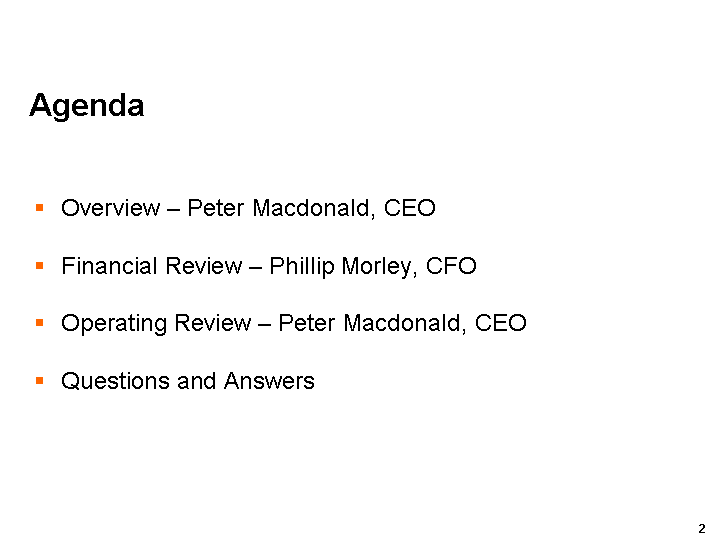
| Overview - Peter Macdonald, CEO Financial Review - Phillip Morley, CFO Operating Review - Peter Macdonald, CEO Questions and Answers Agenda |
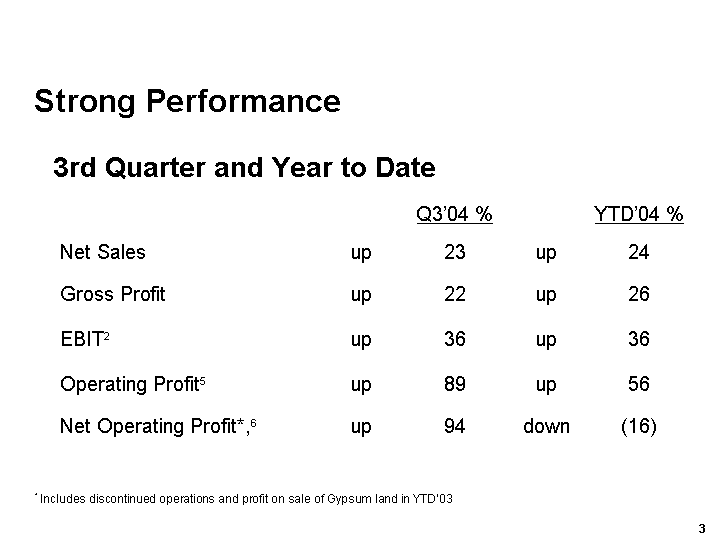
| * Includes discontinued operations and profit on sale of Gypsum land in YTD'03 Strong Performance 3rd Quarter and Year to Date Q3'04 % YTD'04 % Net Sales up 23 up 24 Gross Profit up 22 up 26 EBIT2 up 36 up 36 Operating Profit5 up 89 up 56 Net Operating Profit*,6 up 94 down (16) |
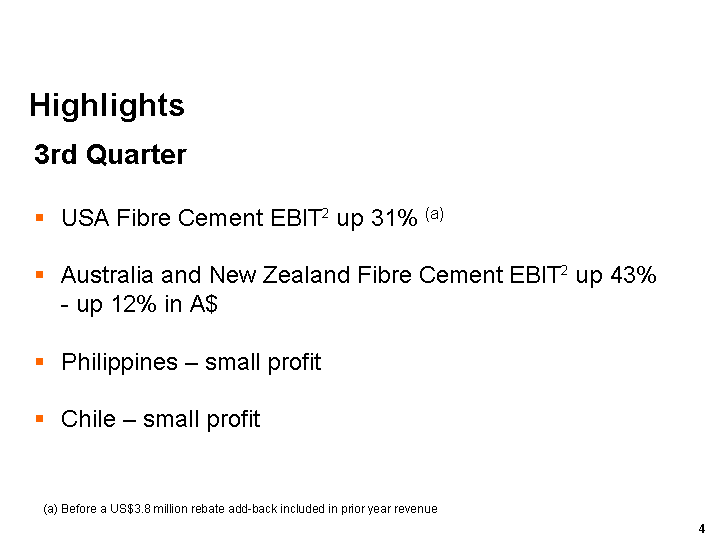
| Highlights 3rd Quarter USA Fibre Cement EBIT2 up 31% (a) Australia and New Zealand Fibre Cement EBIT2 up 43% - - up 12% in A$ Philippines - small profit Chile - small profit (a) Before a US$3.8 million rebate add-back included in prior year revenue |
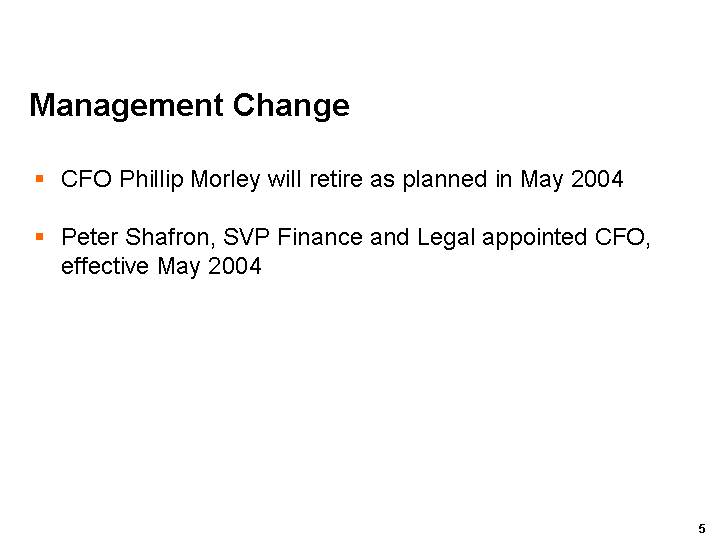
| Management Change CFO Phillip Morley will retire as planned in May 2004 Peter Shafron, SVP Finance and Legal appointed CFO, effective May 2004 |

| Financial Review Phillip Morley, CFO |

| US$ Million Q3 '04 Q3 '03 % Change Net Sales 237.5 192.6 23 Gross Profit 87.5 71.6 22 SG&A (40.6) (37.6) 8 Research & Development (5.7) (4.8) 19 Restructure & Other Operating Expenses - 1.0 (100) EBIT2 41.2 30.2 36 Net Interest Expense (2.8) (12.4) (77) Other Expense, Net (0.1) - - Income Tax Expense (10.0) (2.8) 257 Operating Profit5 28.3 15.0 89 Net Operating Profit Including discontinued Operations6 30.1 15.5 94 Results - Q3 |
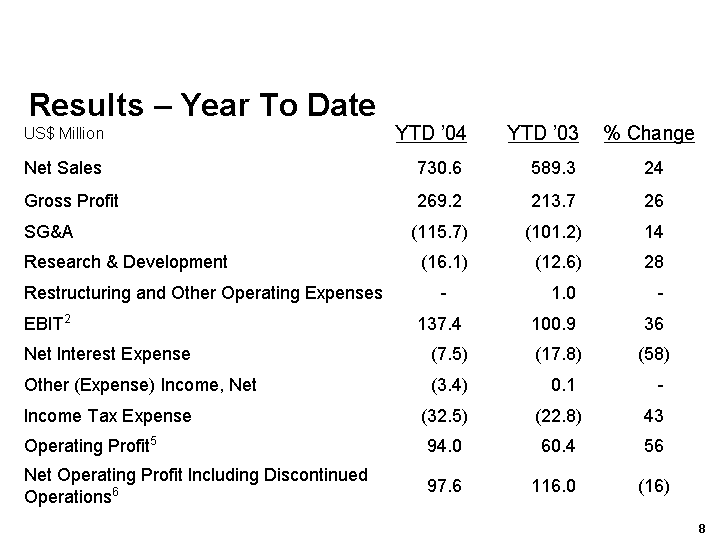
| Results - Year To Date US$ Million YTD '04 YTD '03 % Change Net Sales 730.6 589.3 24 Gross Profit 269.2 213.7 26 SG&A (115.7) (101.2) 14 Research & Development (16.1) (12.6) 28 Restructuring and Other Operating Expenses - 1.0 - EBIT2 137.4 100.9 36 Net Interest Expense (7.5) (17.8) (58) Other (Expense) Income, Net (3.4) 0.1 - Income Tax Expense (32.5) (22.8) 43 Operating Profit5 94.0 60.4 56 Net Operating Profit Including Discontinued Operations6 97.6 116.0 (16) |
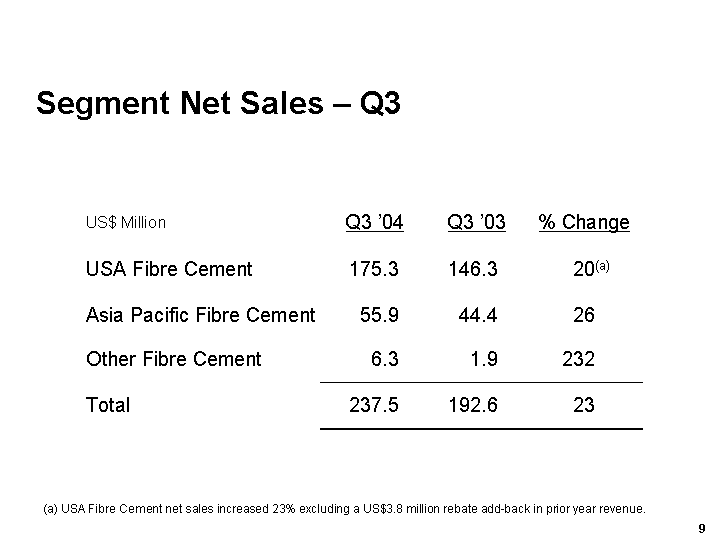
| Segment Net Sales - Q3 US$ Million Q3 '04 Q3 '03 % Change USA Fibre Cement 175.3 146.3 20(a) Asia Pacific Fibre Cement 55.9 44.4 26 Other Fibre Cement 6.3 1.9 232 Total 237.5 192.6 23 (a) USA Fibre Cement net sales increased 23% excluding a US$3.8 million rebate add-back in prior year revenue. |
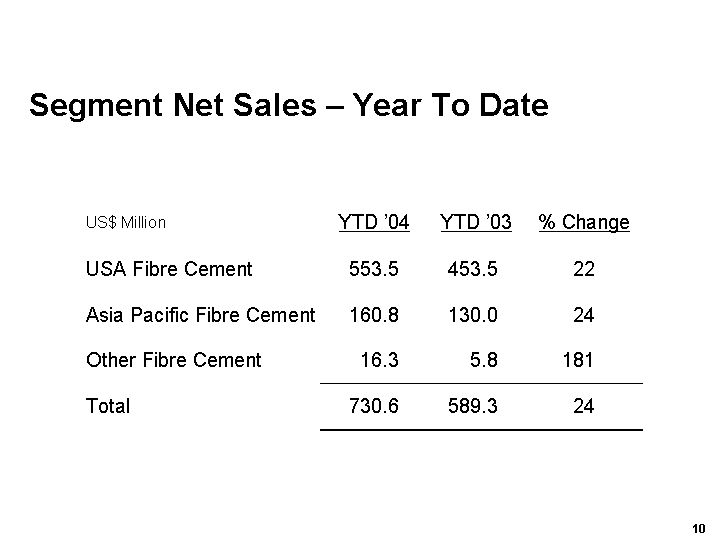
| Segment Net Sales - Year To Date US$ Million YTD '04 YTD '03 % Change USA Fibre Cement 553.5 453.5 22 Asia Pacific Fibre Cement 160.8 130.0 24 Other Fibre Cement 16.3 5.8 181 Total 730.6 589.3 24 |
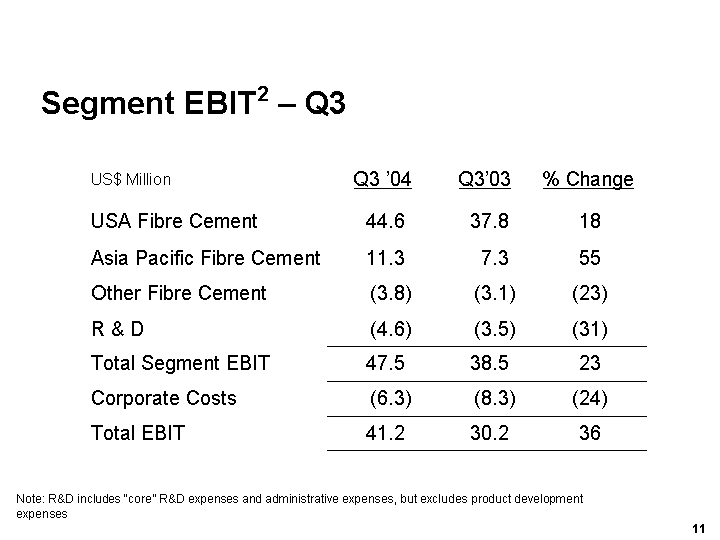
| Segment EBIT2 - Q3 US$ Million Q3 '04 Q3'03 % Change USA Fibre Cement 44.6 37.8 18 Asia Pacific Fibre Cement 11.3 7.3 55 Other Fibre Cement (3.8) (3.1) (23) R & D (4.6) (3.5) (31) Total Segment EBIT 47.5 38.5 23 Corporate Costs (6.3) (8.3) (24) Total EBIT 41.2 30.2 36 Note: R&D includes "core" R&D expenses and administrative expenses, but excludes product development expenses |
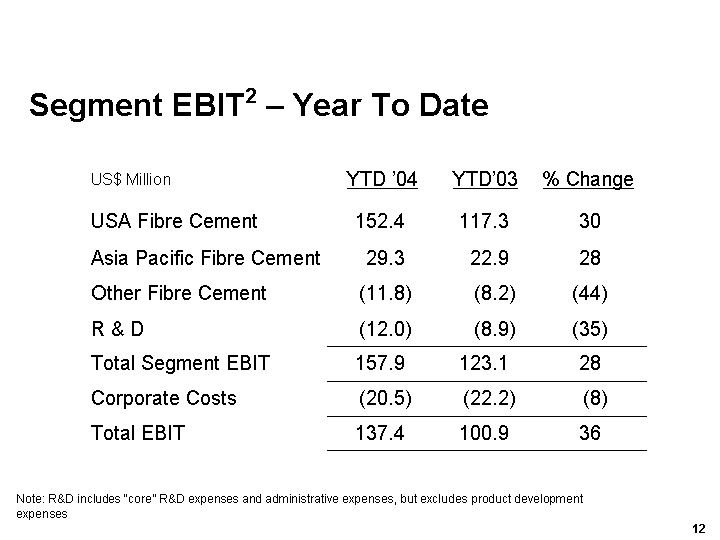
| Segment EBIT2 - Year To Date US$ Million YTD '04 YTD'03 % Change USA Fibre Cement 152.4 117.3 30 Asia Pacific Fibre Cement 29.3 22.9 28 Other Fibre Cement (11.8) (8.2) (44) R & D (12.0) (8.9) (35) Total Segment EBIT 157.9 123.1 28 Corporate Costs (20.5) (22.2) (8) Total EBIT 137.4 100.9 36 Note: R&D includes "core" R&D expenses and administrative expenses, but excludes product development expenses |
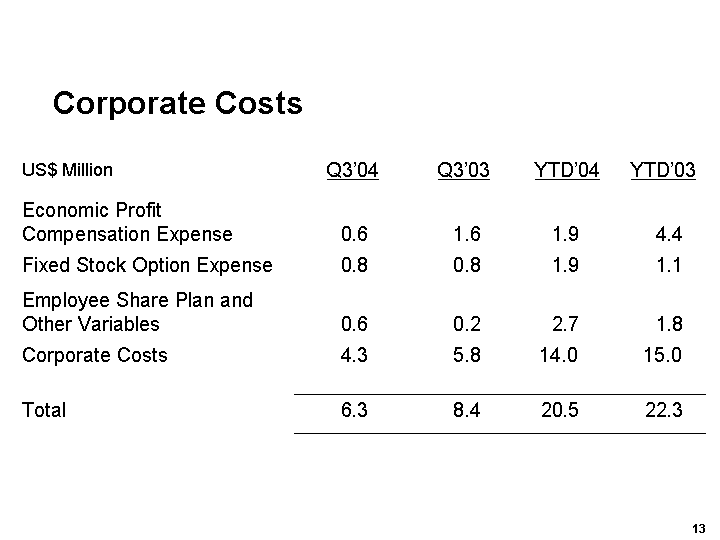
| Corporate Costs US$ Million Q3'04 Q3'03 YTD'04 YTD'03 Economic Profit Compensation Expense 0.6 1.6 1.9 4.4 Fixed Stock Option Expense 0.8 0.8 1.9 1.1 Employee Share Plan and Other Variables 0.6 0.2 2.7 1.8 Corporate Costs 4.3 5.8 14.0 15.0 Total 6.3 8.4 20.5 22.3 |
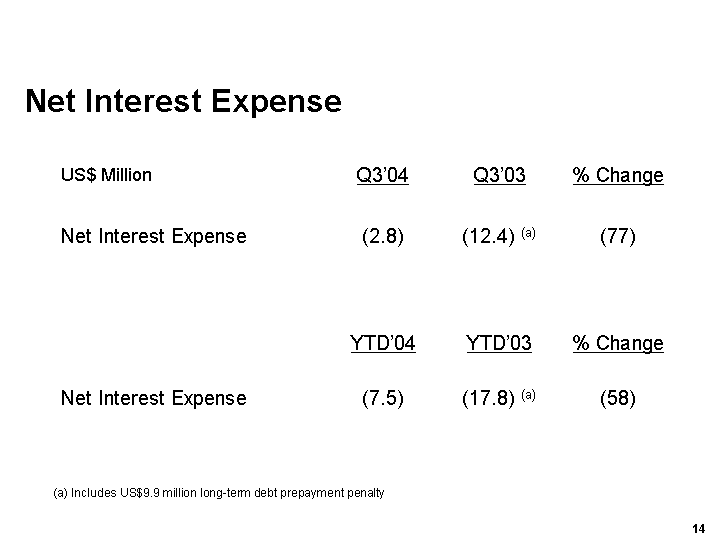
| Net Interest Expense US$ Million Q3'04 Q3'03 % Change Net Interest Expense (2.8) (12.4) (a) (77) YTD'04 YTD'03 % Change Net Interest Expense (7.5) (17.8) (a) (58) (a) Includes US$9.9 million long-term debt prepayment penalty |
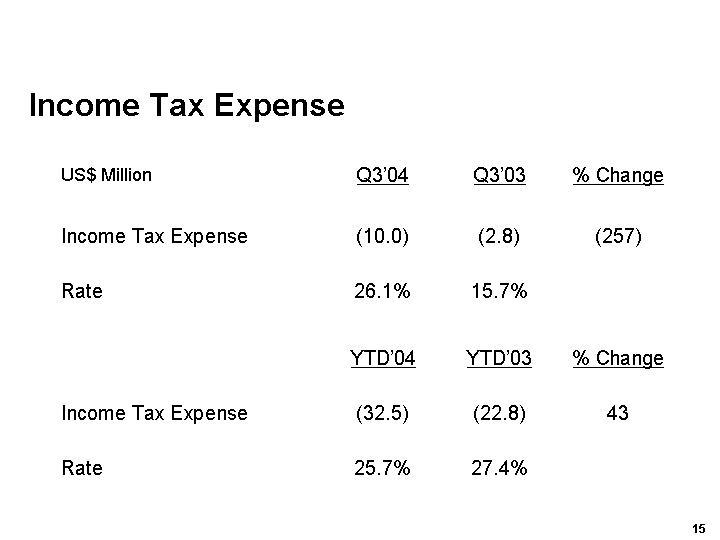
| Income Tax Expense US$ Million Q3'04 Q3'03 % Change Income Tax Expense (10.0) (2.8) (257) Rate 26.1% 15.7% YTD'04 YTD'03 % Change Income Tax Expense (32.5) (22.8) 43 Rate 25.7% 27.4% |
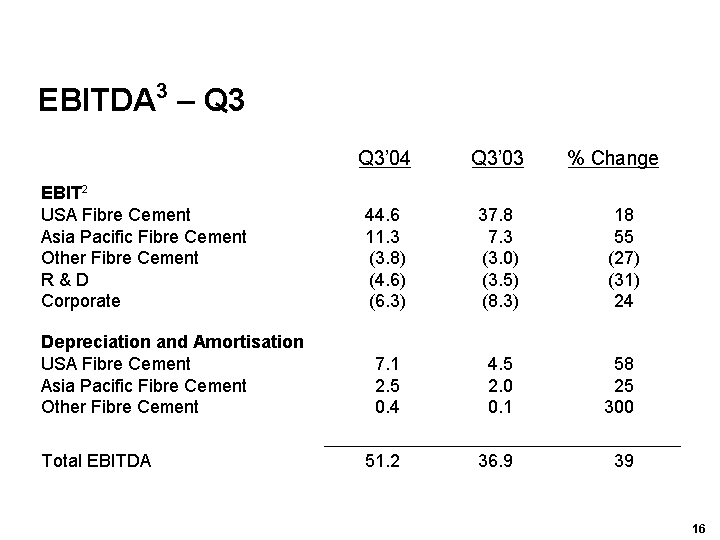
| EBITDA3 - Q3 Q3'04 Q3'03 % Change EBIT2 USA Fibre Cement Asia Pacific Fibre Cement Other Fibre Cement R & D Corporate 44.6 11.3 (3.8) (4.6) (6.3) 37.8 7.3 (3.0) (3.5) (8.3) 18 55 (27) (31) 24 Depreciation and Amortisation USA Fibre Cement Asia Pacific Fibre Cement Other Fibre Cement 7.1 2.5 0.4 4.5 2.0 0.1 58 25 300 Total EBITDA 51.2 36.9 39 |
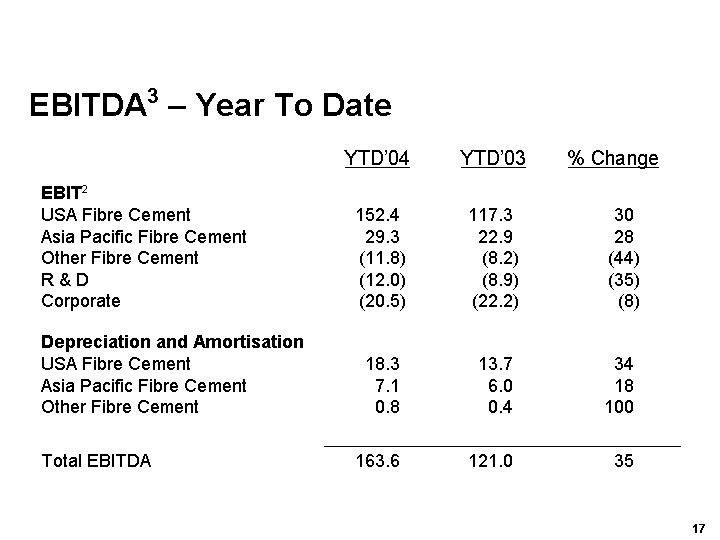
| EBITDA3 - Year To Date YTD'04 YTD'03 % Change EBIT2 USA Fibre Cement Asia Pacific Fibre Cement Other Fibre Cement R & D Corporate 152.4 29.3 (11.8) (12.0) (20.5) 117.3 22.9 (8.2) (8.9) (22.2) 30 28 (44) (35) (8) Depreciation and Amortisation USA Fibre Cement Asia Pacific Fibre Cement Other Fibre Cement 18.3 7.1 0.8 13.7 6.0 0.4 34 18 100 Total EBITDA 163.6 121.0 35 |
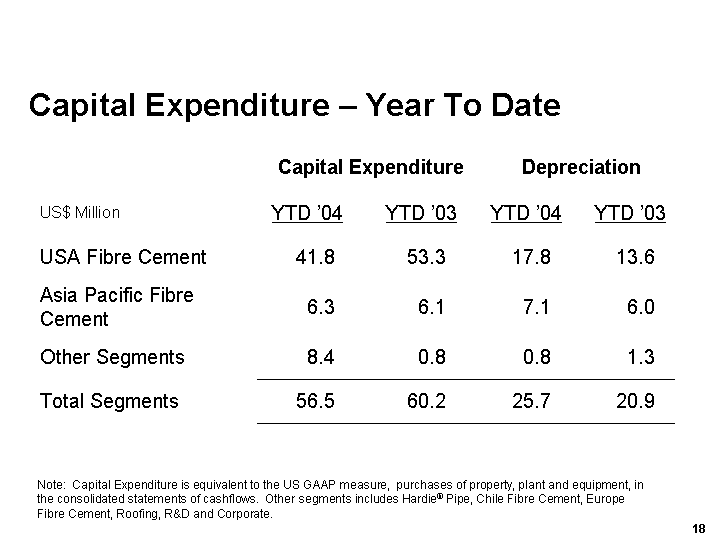
| Capital Expenditure - Year To Date Capital Expenditure Capital Expenditure Depreciation Depreciation US$ Million YTD '04 YTD '03 YTD '04 YTD '03 USA Fibre Cement 41.8 53.3 17.8 13.6 Asia Pacific Fibre Cement 6.3 6.1 7.1 6.0 Other Segments 8.4 0.8 0.8 1.3 Total Segments 56.5 60.2 25.7 20.9 Note: Capital Expenditure is equivalent to the US GAAP measure, purchases of property, plant and equipment, in the consolidated statements of cashflows. Other segments includes Hardie(r) Pipe, Chile Fibre Cement, Europe Fibre Cement, Roofing, R&D and Corporate. |
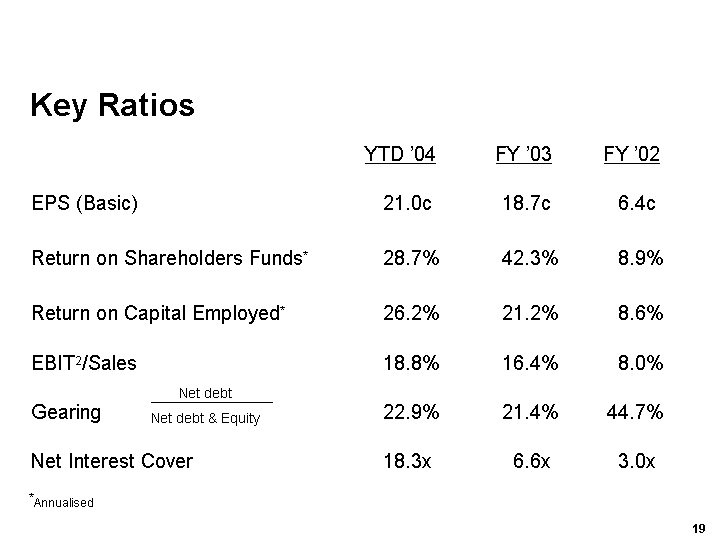
| Key Ratios YTD '04 FY '03 FY '02 EPS (Basic) 21.0c 18.7c 6.4c Return on Shareholders Funds* 28.7% 42.3% 8.9% Return on Capital Employed* 26.2% 21.2% 8.6% EBIT2/Sales 18.8% 16.4% 8.0% Gearing 22.9% 21.4% 44.7% Net Interest Cover 18.3x 6.6x 3.0x *Annualised |
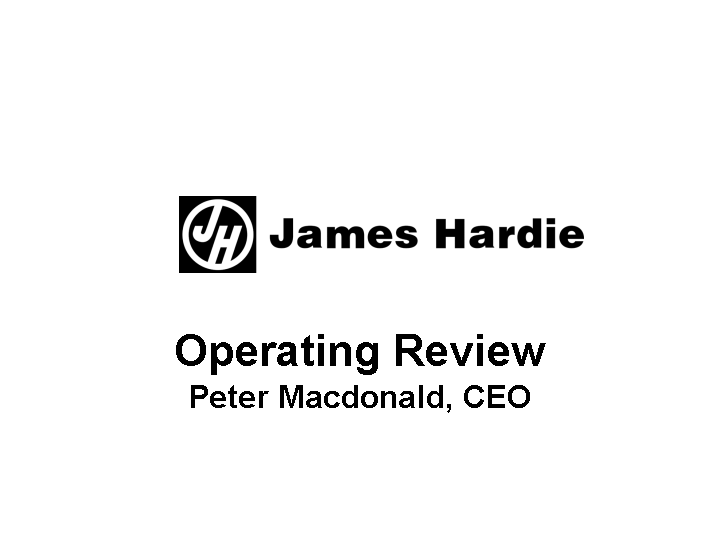
| Operating Review Peter Macdonald, CEO |
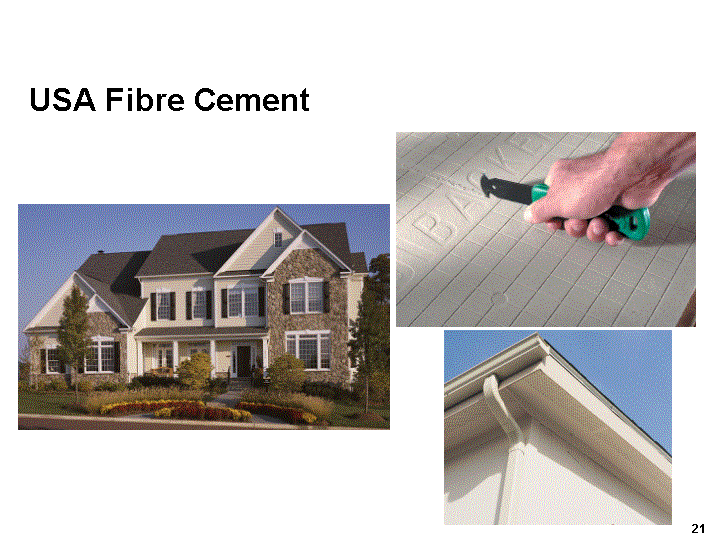
| USA Fibre Cement |

| Strong 3rd Quarter Result Net Sales(a) up 23% to US$175.3 million Sales Volume up 20% to 358.3 mmsf Average Price (a) up 2% to US$489 per msf EBIT2 (a) up 31% to US$44.6 million EBIT Margin2 up 2.2 pts to 25.4% USA Fibre Cement (a) Excludes a US$3.8 million rebate add-back in prior year revenue. |
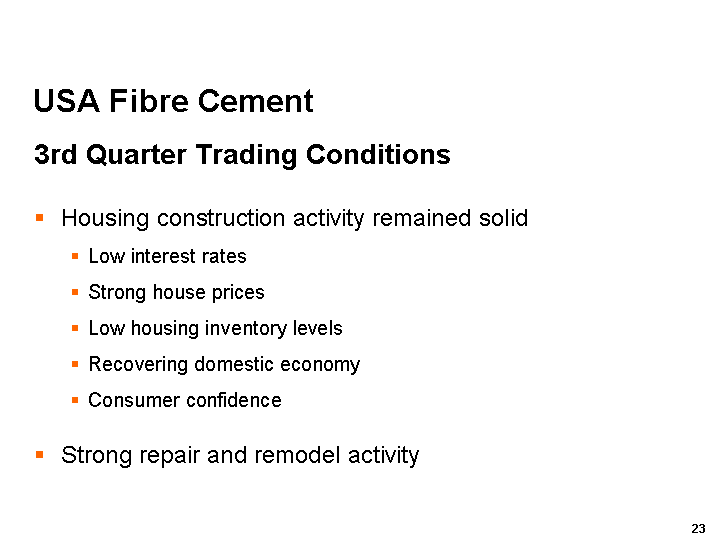
| USA Fibre Cement 3rd Quarter Trading Conditions Housing construction activity remained solid Low interest rates Strong house prices Low housing inventory levels Recovering domestic economy Consumer confidence Strong repair and remodel activity |
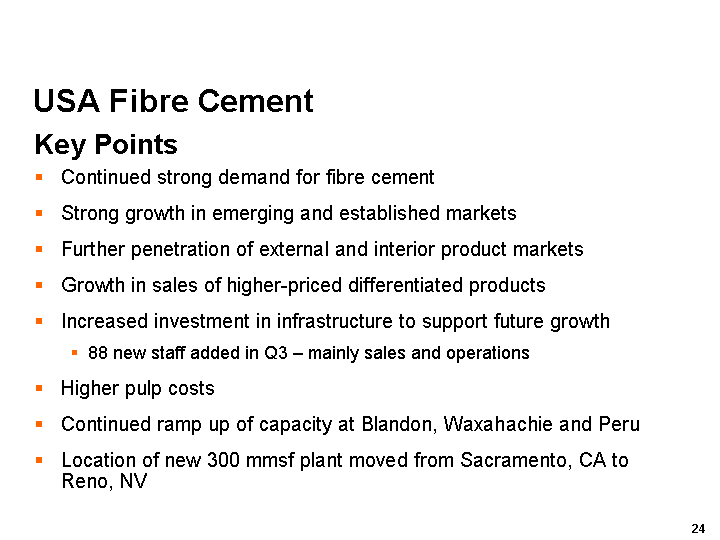
| USA Fibre Cement Key Points Continued strong demand for fibre cement Strong growth in emerging and established markets Further penetration of external and interior product markets Growth in sales of higher-priced differentiated products Increased investment in infrastructure to support future growth 88 new staff added in Q3 - mainly sales and operations Higher pulp costs Continued ramp up of capacity at Blandon, Waxahachie and Peru Location of new 300 mmsf plant moved from Sacramento, CA to Reno, NV |
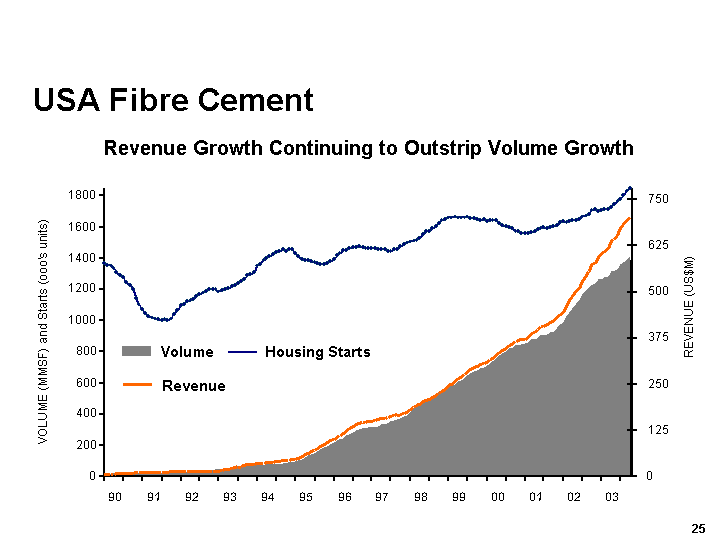
| USA Fibre Cement Revenue Growth Continuing to Outstrip Volume Growth 0 200 400 600 800 1000 1200 1400 1600 1800 90 91 92 93 94 95 96 97 98 99 00 01 02 03 VOLUME (MMSF) and Starts (ooo's units) 0 125 250 375 500 625 750 REVENUE (US$M) Volume Revenue Housing Starts |
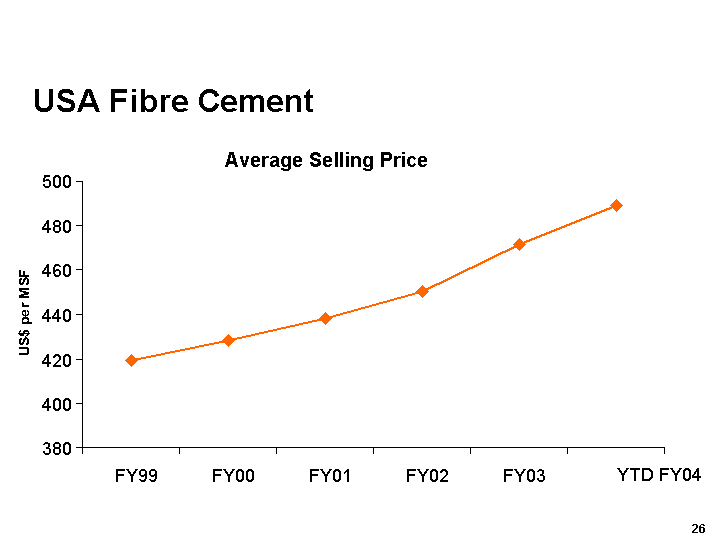
| USA Fibre Cement Average Selling Price US$ per MSF |
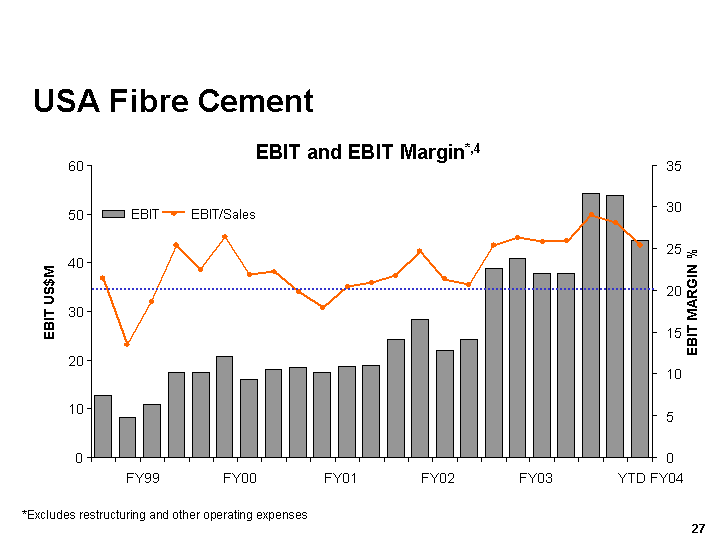
| USA Fibre Cement *Excludes restructuring and other operating expenses 0 10 20 30 40 50 60 FY99 FY00 FY01 FY02 FY03 YTD FY04 EBIT US$M 0 5 10 15 20 25 30 35 EBIT MARGIN % EBIT EBIT/Sales EBIT and EBIT Margin*,4 |

| USA Fibre Cement Strategy Aggressively grow market for fibre cement Grow our overall market position while defending our share in existing market segments Offer products with superior value to that of our competitors, introducing differentiated products to reduce direct price competition |
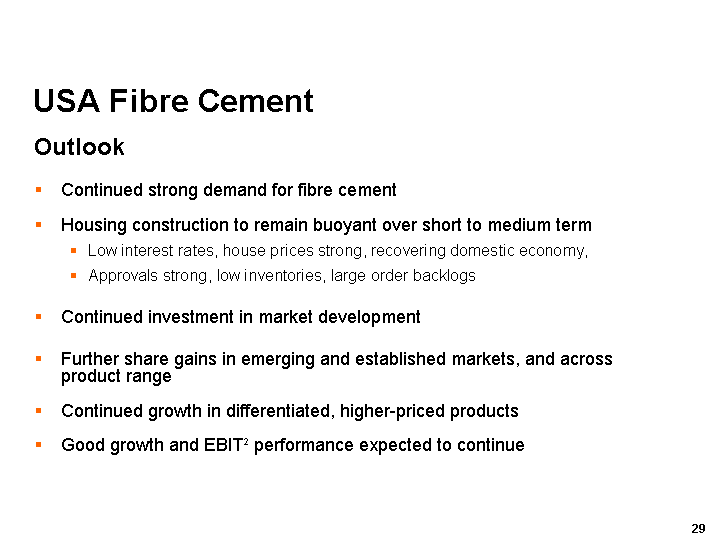
| USA Fibre Cement Outlook Continued strong demand for fibre cement Housing construction to remain buoyant over short to medium term Low interest rates, house prices strong, recovering domestic economy, Approvals strong, low inventories, large order backlogs Continued investment in market development Further share gains in emerging and established markets, and across product range Continued growth in differentiated, higher-priced products Good growth and EBIT2 performance expected to continue |
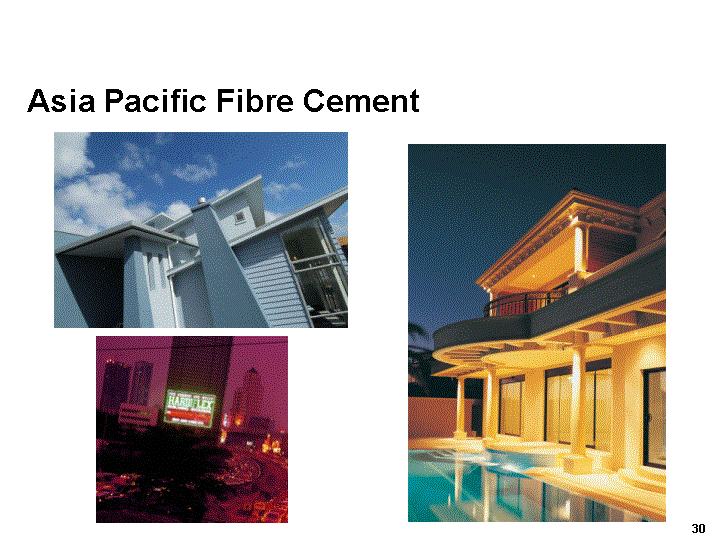
| Asia Pacific Fibre Cement |
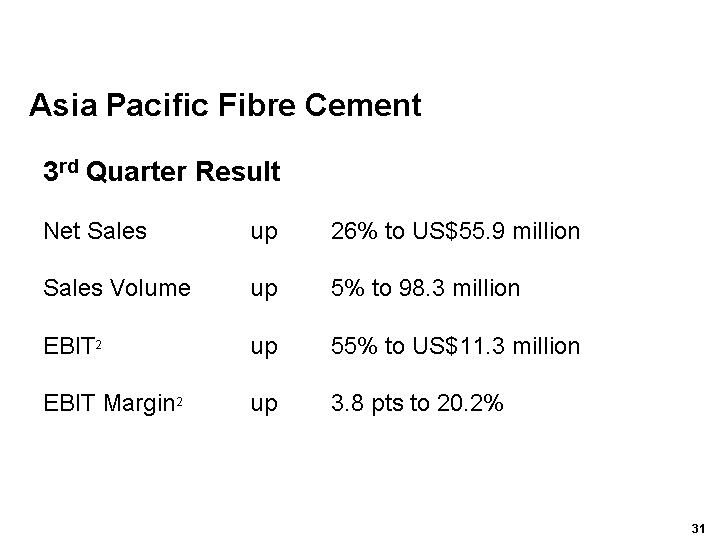
| Asia Pacific Fibre Cement 3rd Quarter Result Net Sales up 26% to US$55.9 million Sales Volume up 5% to 98.3 million EBIT2 up 55% to US$11.3 million EBIT Margin2 up 3.8 pts to 20.2% |
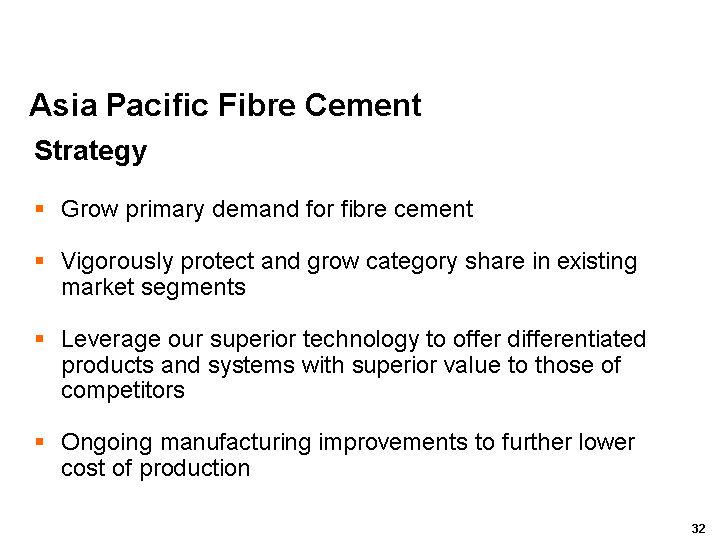
| Strategy Grow primary demand for fibre cement Vigorously protect and grow category share in existing market segments Leverage our superior technology to offer differentiated products and systems with superior value to those of competitors Ongoing manufacturing improvements to further lower cost of production Asia Pacific Fibre Cement |
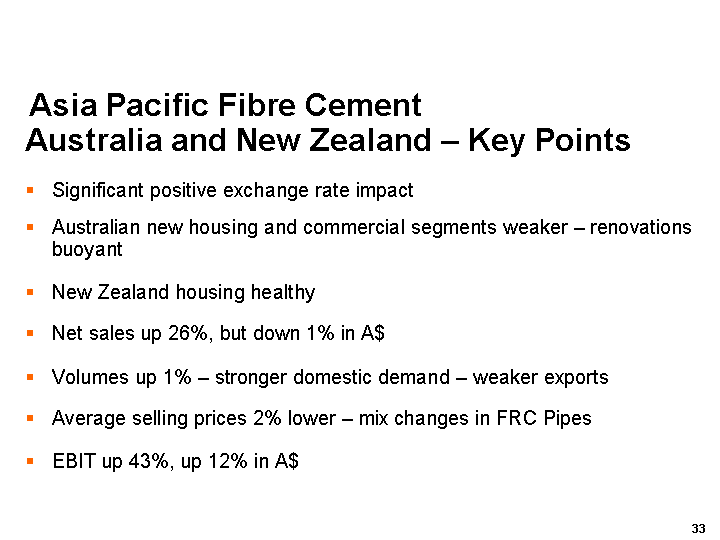
| Australia and New Zealand - Key Points Significant positive exchange rate impact Australian new housing and commercial segments weaker - renovations buoyant New Zealand housing healthy Net sales up 26%, but down 1% in A$ Volumes up 1% - stronger domestic demand - weaker exports Average selling prices 2% lower - mix changes in FRC Pipes EBIT up 43%, up 12% in A$ Asia Pacific Fibre Cement |
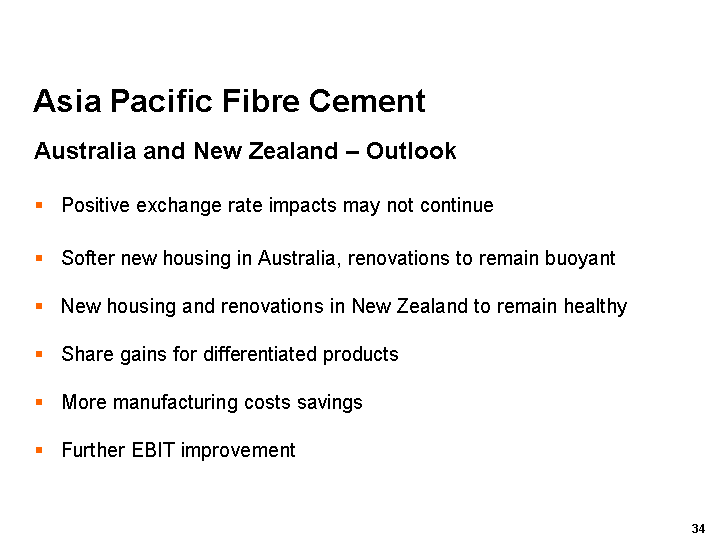
| Asia Pacific Fibre Cement Australia and New Zealand - Outlook Positive exchange rate impacts may not continue Softer new housing in Australia, renovations to remain buoyant New housing and renovations in New Zealand to remain healthy Share gains for differentiated products More manufacturing costs savings Further EBIT improvement |
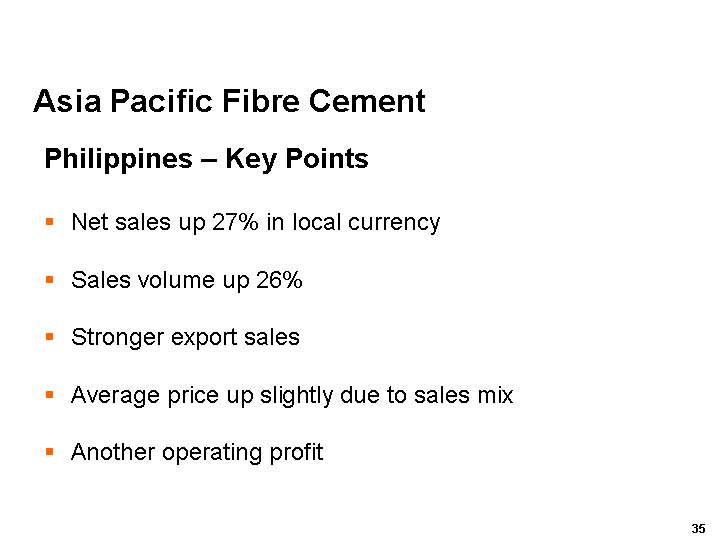
| Asia Pacific Fibre Cement Philippines - Key Points Net sales up 27% in local currency Sales volume up 26% Stronger export sales Average price up slightly due to sales mix Another operating profit |
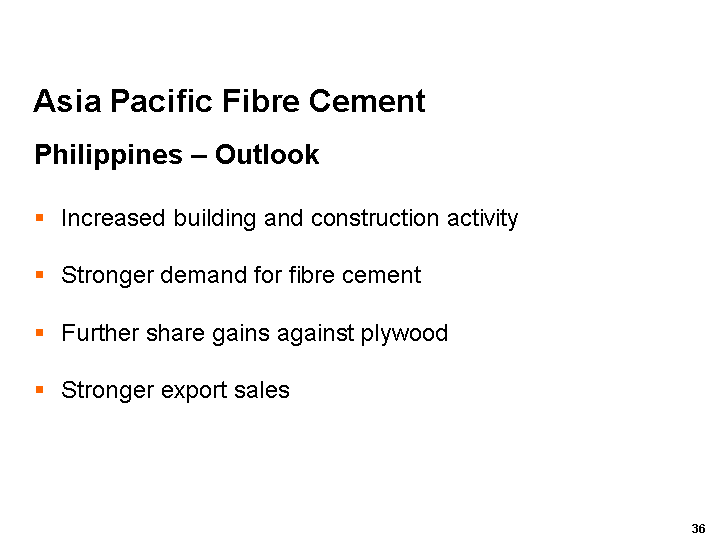
| Asia Pacific Fibre Cement Philippines - Outlook Increased building and construction activity Stronger demand for fibre cement Further share gains against plywood Stronger export sales |
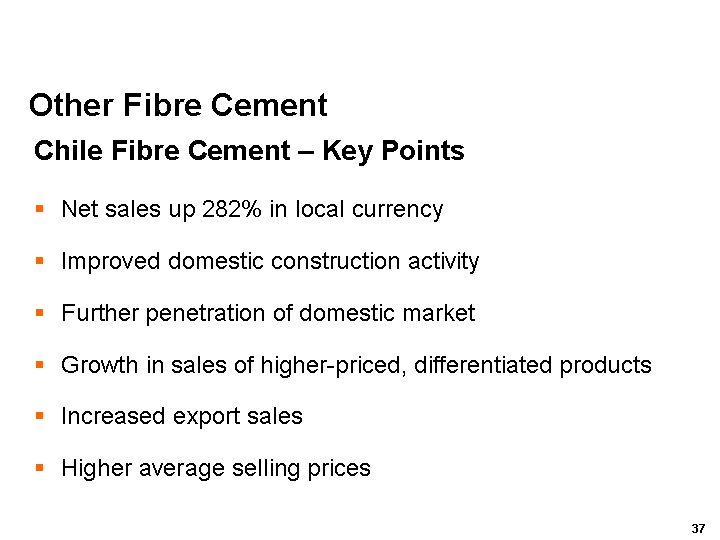
| Other Fibre Cement Chile Fibre Cement - Key Points Net sales up 282% in local currency Improved domestic construction activity Further penetration of domestic market Growth in sales of higher-priced, differentiated products Increased export sales Higher average selling prices |
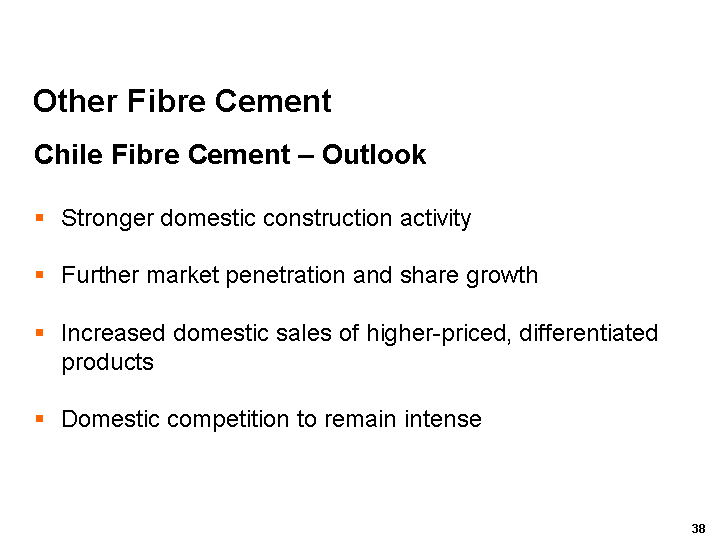
| Other Fibre Cement Chile Fibre Cement - Outlook Stronger domestic construction activity Further market penetration and share growth Increased domestic sales of higher-priced, differentiated products Domestic competition to remain intense |

| Other Fibre Cement USA Hardie(r) Pipe - Key Points Increased penetration of SE market lifted sales 82% Lower costs and improved manufacturing performance - but costs still above target Higher average prices, but still low due to competition |
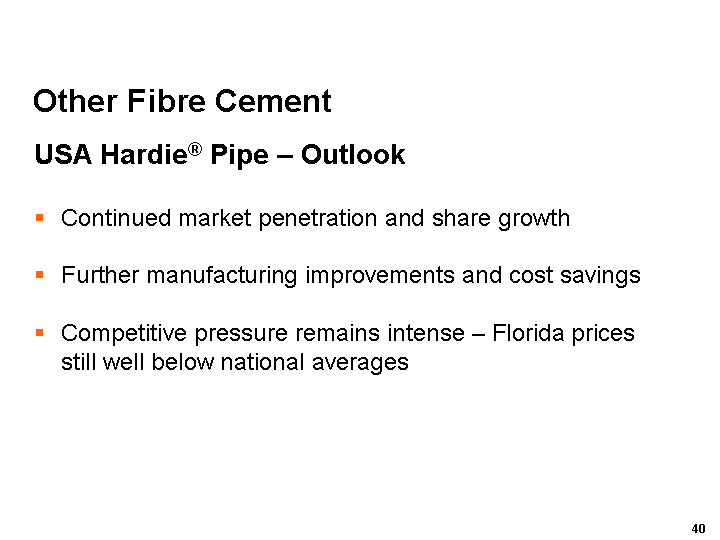
| Other Fibre Cement USA Hardie(r) Pipe - Outlook Continued market penetration and share growth Further manufacturing improvements and cost savings Competitive pressure remains intense - Florida prices still well below national averages |
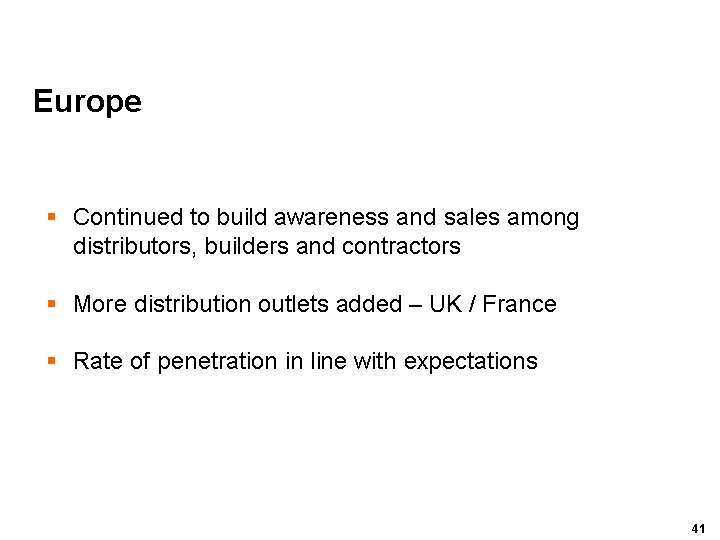
| Europe Continued to build awareness and sales among distributors, builders and contractors More distribution outlets added - UK / France Rate of penetration in line with expectations |
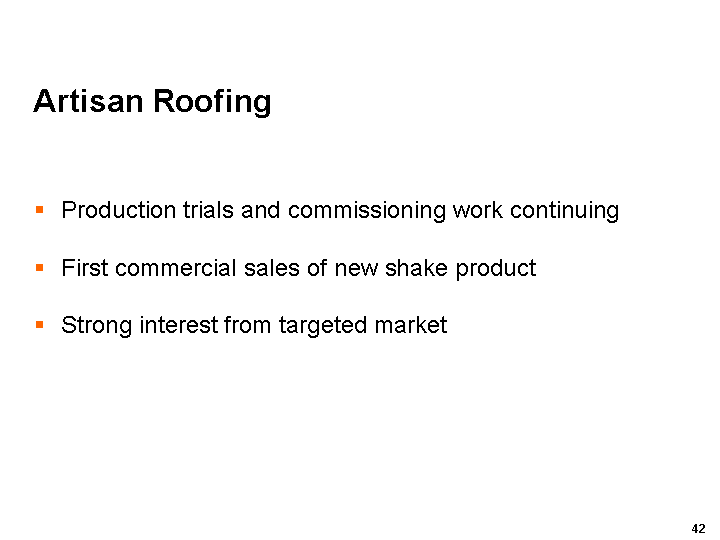
| Artisan Roofing Production trials and commissioning work continuing First commercial sales of new shake product Strong interest from targeted market |

| Research and Development Key driver of growth Core projects engineered raw materials product formulations engineering and process technologies lightweight and durable products for all climates Sustainable competitive advantage continuing to be built |
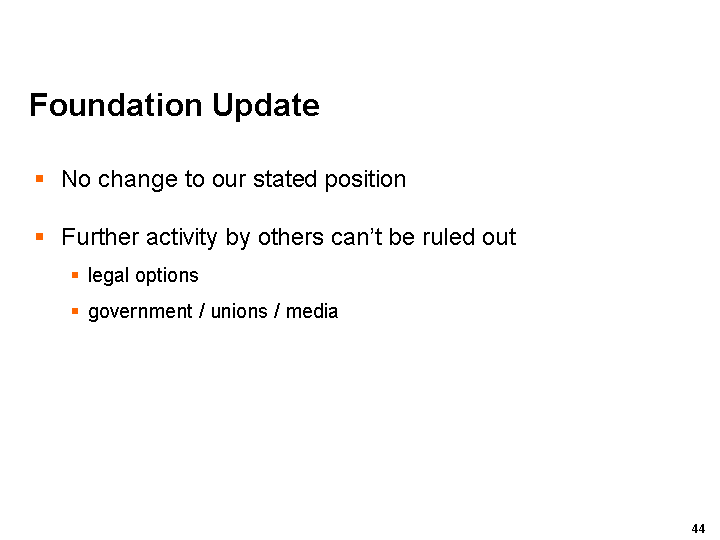
| Foundation Update No change to our stated position Further activity by others can't be ruled out legal options government / unions / media |
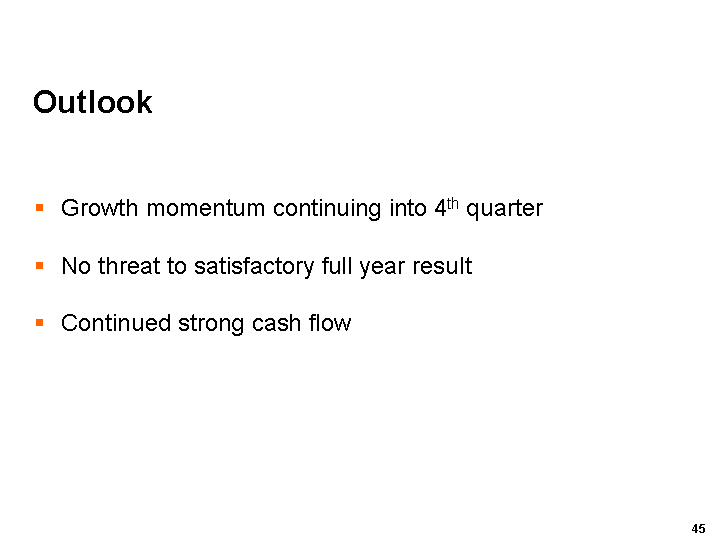
| Outlook Growth momentum continuing into 4th quarter No threat to satisfactory full year result Continued strong cash flow |
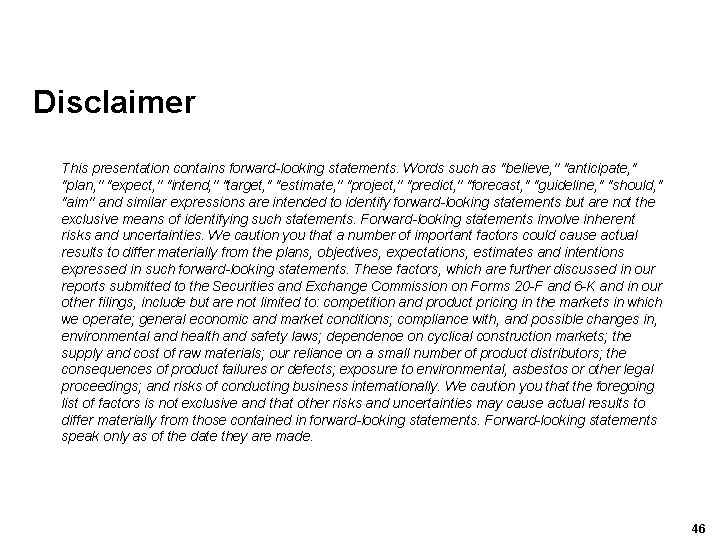
| Disclaimer This presentation contains forward-looking statements. Words such as "believe,'' "anticipate,'' "plan,'' "expect,'' "intend,'' "target,'' "estimate,'' "project,'' "predict,'' "forecast,'' "guideline,'' "should,'' "aim'' and similar expressions are intended to identify forward-looking statements but are not the exclusive means of identifying such statements. Forward-looking statements involve inherent risks and uncertainties. We caution you that a number of important factors could cause actual results to differ materially from the plans, objectives, expectations, estimates and intentions expressed in such forward-looking statements. These factors, which are further discussed in our reports submitted to the Securities and Exchange Commission on Forms 20-F and 6-K and in our other filings, include but are not limited to: competition and product pricing in the markets in which we operate; general economic and market conditions; compliance with, and possible changes in, environmental and health and safety laws; dependence on cyclical construction markets; the supply and cost of raw materials; our reliance on a small number of product distributors; the consequences of product failures or defects; exposure to environmental, asbestos or other legal proceedings; and risks of conducting business internationally. We caution you that the foregoing list of factors is not exclusive and that other risks and uncertainties may cause actual results to differ materially from those contained in forward-looking statements. Forward-looking statements speak only as of the date they are made. |
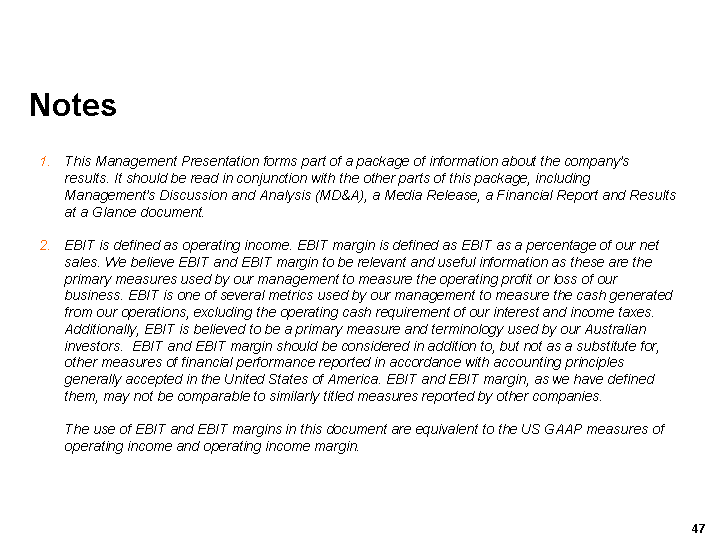
| Notes This Management Presentation forms part of a package of information about the company's results. It should be read in conjunction with the other parts of this package, including Management's Discussion and Analysis (MD&A), a Media Release, a Financial Report and Results at a Glance document. EBIT is defined as operating income. EBIT margin is defined as EBIT as a percentage of our net sales. We believe EBIT and EBIT margin to be relevant and useful information as these are the primary measures used by our management to measure the operating profit or loss of our business. EBIT is one of several metrics used by our management to measure the cash generated from our operations, excluding the operating cash requirement of our interest and income taxes. Additionally, EBIT is believed to be a primary measure and terminology used by our Australian investors. EBIT and EBIT margin should be considered in addition to, but not as a substitute for, other measures of financial performance reported in accordance with accounting principles generally accepted in the United States of America. EBIT and EBIT margin, as we have defined them, may not be comparable to similarly titled measures reported by other companies. The use of EBIT and EBIT margins in this document are equivalent to the US GAAP measures of operating income and operating income margin. |
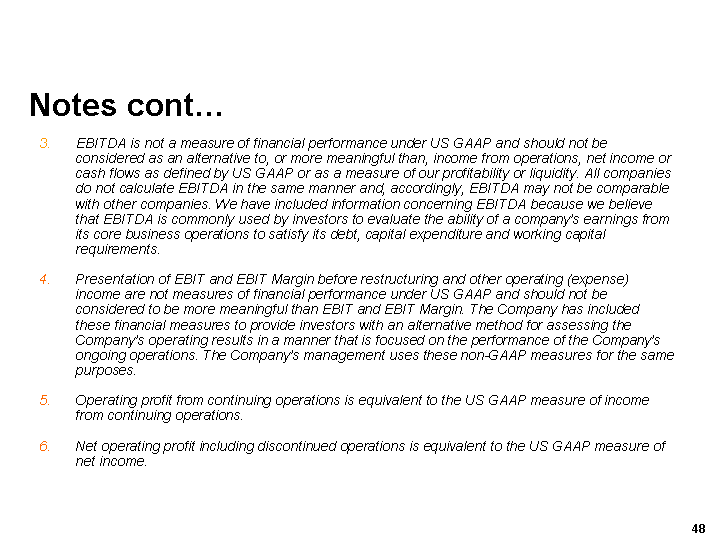
| Notes cont... 3. EBITDA is not a measure of financial performance under US GAAP and should not be considered as an alternative to, or more meaningful than, income from operations, net income or cash flows as defined by US GAAP or as a measure of our profitability or liquidity. All companies do not calculate EBITDA in the same manner and, accordingly, EBITDA may not be comparable with other companies. We have included information concerning EBITDA because we believe that EBITDA is commonly used by investors to evaluate the ability of a company's earnings from its core business operations to satisfy its debt, capital expenditure and working capital requirements. 4. Presentation of EBIT and EBIT Margin before restructuring and other operating (expense) income are not measures of financial performance under US GAAP and should not be considered to be more meaningful than EBIT and EBIT Margin. The Company has included these financial measures to provide investors with an alternative method for assessing the Company's operating results in a manner that is focused on the performance of the Company's ongoing operations. The Company's management uses these non-GAAP measures for the same purposes. Operating profit from continuing operations is equivalent to the US GAAP measure of income from continuing operations. Net operating profit including discontinued operations is equivalent to the US GAAP measure of net income. |
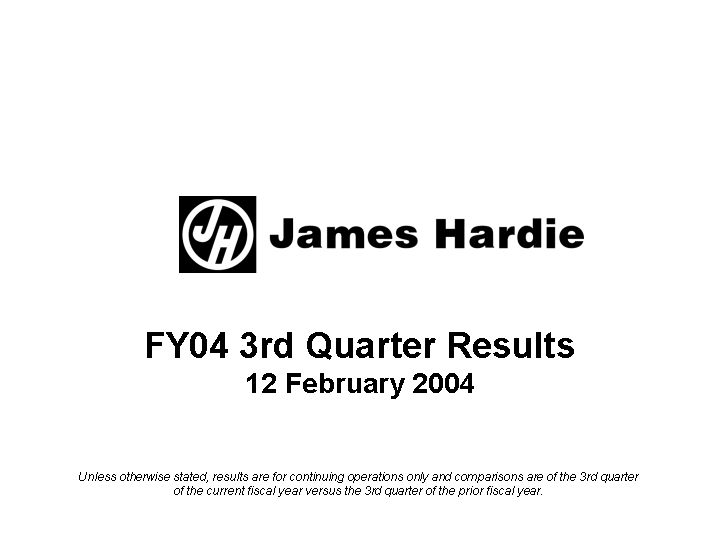
| FY04 3rd Quarter Results 12 February 2004 Unless otherwise stated, results are for continuing operations only and comparisons are of the 3rd quarter of the current fiscal year versus the 3rd quarter of the prior fiscal year. |
James Hardie Industries N.V.
and
Subsidiaries
Financial Report
31 December 2003
INDEX
| Page | ||||||
Item 1. |
Financial Statements |
|||||
Consolidated Balance Sheets as of 31 December 2003 and 31 March 2003 |
1 | |||||
Consolidated Statements of Income for the Three and Nine Months Ended 31 December 2003 and 2002 |
2 | |||||
Consolidated Statements of Cash Flows for the Nine Months Ended 31 December 2003 and 2002 |
4 | |||||
Consolidated Statement of Changes in Shareholders’ Equity for the Nine Months |
6 | |||||
Ended 31 December 2003 |
||||||
Notes to Consolidated Financial Statements |
7 | |||||
Item 2. |
Quantitative and Qualitative Disclosures About Market Risk |
13 | ||||
Item 1. Financial Statements
JAMES HARDIE INDUSTRIES N.V. AND SUBSIDIARIES
CONSOLIDATED BALANCE SHEETS
| (Millions of US dollars) |
(Millions of Australian dollars) |
|||||||||||||||
| 31 December | 31 March | 31 December | 31 March | |||||||||||||
| 2003 |
2003 |
2003 |
2003 |
|||||||||||||
| ASSETS | (Unaudited) | (Unaudited) | (Unaudited) | |||||||||||||
Current assets: |
||||||||||||||||
Cash and cash equivalents |
$ | 38.5 | $ | 54.6 | A$ | 51.3 | A$ | 90.4 | ||||||||
Accounts and notes receivable, net of allowance for
doubtful accounts of $1.2 million (A$1.6 million) and
$1.0 million (A$1.7 million) as of 31 December 2003 and
31 March 2003, respectively |
91.6 | 87.8 | 122.0 | 145.4 | ||||||||||||
Inventories |
90.4 | 74.0 | 120.4 | 122.5 | ||||||||||||
Refundable income taxes |
4.1 | 20.4 | 5.5 | 33.8 | ||||||||||||
Prepaid expenses and other current assets |
9.6 | 6.6 | 12.8 | 10.9 | ||||||||||||
Deferred tax assets |
31.1 | 23.0 | 41.4 | 38.1 | ||||||||||||
Current assets — discontinued operations |
— | 5.4 | — | 8.9 | ||||||||||||
Total current assets |
265.3 | 271.8 | 353.4 | 450.0 | ||||||||||||
Long-term receivables |
6.0 | 3.7 | 8.0 | 6.1 | ||||||||||||
Investments |
5.8 | 6.0 | 7.7 | 9.9 | ||||||||||||
Property, plant and equipment, net |
567.5 | 520.0 | 755.6 | 861.1 | ||||||||||||
Intangible assets, net |
3.3 | 3.4 | 4.4 | 5.6 | ||||||||||||
Deferred tax assets |
15.0 | 21.4 | 20.0 | 35.4 | ||||||||||||
Non-current assets — discontinued operations |
— | 1.3 | — | 2.2 | ||||||||||||
Total assets |
$ | 862.9 | $ | 827.6 | A$ | 1,149.1 | A$ | 1,370.3 | ||||||||
LIABILITIES AND SHAREHOLDERS’ EQUITY |
||||||||||||||||
Current liabilities: |
||||||||||||||||
Accounts payable and accrued liabilities |
$ | 65.6 | $ | 74.0 | A$ | 87.3 | A$ | 122.5 | ||||||||
Current portion of long term debt |
17.6 | — | 23.4 | — | ||||||||||||
Short-term debt |
11.3 | 8.8 | 15.0 | 14.6 | ||||||||||||
Accrued payroll and employee benefits |
33.2 | 31.6 | 44.2 | 52.3 | ||||||||||||
Accrued product warranties |
11.6 | 7.3 | 15.4 | 12.1 | ||||||||||||
Income taxes payable |
16.9 | 7.7 | 22.5 | 12.8 | ||||||||||||
Other liabilities |
5.4 | 4.9 | 7.2 | 8.1 | ||||||||||||
Current liabilities — discontinued operations |
— | 2.3 | — | 3.8 | ||||||||||||
Total current liabilities |
161.6 | 136.6 | 215.0 | 226.2 | ||||||||||||
Long-term debt |
147.4 | 165.0 | 196.2 | 273.2 | ||||||||||||
Deferred income taxes |
73.9 | 65.5 | 98.4 | 108.5 | ||||||||||||
Accrued product warranties |
0.9 | 7.5 | 1.2 | 12.4 | ||||||||||||
Other liabilities |
15.3 | 18.3 | 20.4 | 30.3 | ||||||||||||
Total liabilities |
399.1 | 392.9 | A$ | 531.2 | A$ | 650.6 | ||||||||||
Commitments and contingencies (Note 8) |
||||||||||||||||
Shareholders’ equity: |
||||||||||||||||
Common stock, 2.0 billion shares authorized;
Euro 0.59 par value, 458,418,418 shares issued and
outstanding at 31 December 2003 and Euro 0.64
par value, 457,514,598 shares issued and outstanding
at 31 March 2003 |
245.1 | 269.7 | ||||||||||||||
Additional paid-in capital |
132.1 | 171.3 | ||||||||||||||
Retained earnings |
119.1 | 44.4 | ||||||||||||||
Employee loans |
(4.0 | ) | (4.4 | ) | ||||||||||||
Accumulated other comprehensive loss |
(28.5 | ) | (46.3 | ) | ||||||||||||
Total shareholders’ equity |
463.8 | 434.7 | ||||||||||||||
Total liabilities and shareholders’ equity |
$ | 862.9 | $ | 827.6 | ||||||||||||
The accompanying notes are an integral part of these interim consolidated financial statements.
F-1
JAMES HARDIE INDUSTRIES N.V. AND SUBSIDIARIES
CONSOLIDATED STATEMENTS OF INCOME
(Unaudited)
| Three Months | Nine Months | |||||||||||||||
| Ended 31 December |
Ended 31 December |
|||||||||||||||
| (Millions of US dollars, except per share data) |
2003 |
2002 |
2003 |
2002 |
||||||||||||
Net sales |
$ | 237.5 | $ | 192.6 | $ | 730.6 | $ | 589.3 | ||||||||
Cost of goods sold |
(150.0 | ) | (121.0 | ) | (461.4 | ) | (375.6 | ) | ||||||||
Gross profit |
87.5 | 71.6 | 269.2 | 213.7 | ||||||||||||
Selling, general and administrative expenses |
(40.6 | ) | (37.6 | ) | (115.7 | ) | (101.2 | ) | ||||||||
Research and development expenses |
(5.7 | ) | (4.8 | ) | (16.1 | ) | (12.6 | ) | ||||||||
Other operating income |
— | 1.0 | — | 1.0 | ||||||||||||
Operating income |
41.2 | 30.2 | 137.4 | 100.9 | ||||||||||||
Interest expense |
(3.0 | ) | (13.5 | ) | (8.3 | ) | (21.3 | ) | ||||||||
Interest income |
0.2 | 1.1 | 0.8 | 3.5 | ||||||||||||
Other (expense) income |
(0.1 | ) | — | (3.4 | ) | 0.1 | ||||||||||
Income from continuing operations before income taxes |
38.3 | 17.8 | 126.5 | 83.2 | ||||||||||||
Income tax expense |
(10.0 | ) | (2.8 | ) | (32.5 | ) | (22.8 | ) | ||||||||
Income from continuing operations |
28.3 | 15.0 | 94.0 | 60.4 | ||||||||||||
Discontinued operations: |
||||||||||||||||
Income from discontinued operations, net of income tax expense
of $0.2 million for the three months ended 31 December 2002
and net of income tax expense of $0.1 million and $1.4 million
for the nine months ended 31 December 2003 and 2002, respectively |
— | 0.5 | 0.2 | 2.7 | ||||||||||||
Gain on disposal of discontinued operations, net of income tax benefit
of $4.3 million and $0.2 million for the three months ended
31 December 2003 and 2002, respectively and net of income tax
benefit (expense) of $4.4 million and ($27.1) million for the nine
months ended 31 December 2003 and 2002, respectively |
1.8 | — | 3.4 | 52.9 | ||||||||||||
Income from discontinued operations |
1.8 | 0.5 | 3.6 | 55.6 | ||||||||||||
Net income |
$ | 30.1 | $ | 15.5 | $ | 97.6 | $ | 116.0 | ||||||||
Income per share — basic: |
||||||||||||||||
Income from continuing operations |
$ | 0.06 | $ | 0.03 | $ | 0.20 | $ | 0.13 | ||||||||
Income from discontinued operations |
0.01 | — | 0.01 | 0.12 | ||||||||||||
Net income per share — basic |
$ | 0.07 | $ | 0.03 | $ | 0.21 | $ | 0.25 | ||||||||
Income per share — diluted: |
||||||||||||||||
Income from continuing operations |
$ | 0.06 | $ | 0.03 | $ | 0.20 | $ | 0.13 | ||||||||
Income from discontinued operations |
0.01 | — | 0.01 | 0.12 | ||||||||||||
Net income per share — diluted |
$ | 0.07 | $ | 0.03 | $ | 0.21 | $ | 0.25 | ||||||||
Weighted average common shares outstanding (in millions): |
||||||||||||||||
Basic |
458.2 | 456.9 | 457.9 | 456.4 | ||||||||||||
Diluted |
461.9 | 459.6 | 461.3 | 459.1 | ||||||||||||
The accompanying notes are an integral part of these interim consolidated financial statements.
F-2
JAMES HARDIE INDUSTRIES N.V. AND SUBSIDIARIES
CONSOLIDATED STATEMENTS OF INCOME
(Unaudited)
| Three Months | Nine Months | |||||||||||||||
| Ended 31 December |
Ended 31 December |
|||||||||||||||
| (Millions of Australian dollars, except per share data) |
2003 |
2002 |
2003 |
2002 |
||||||||||||
Net sales |
A$ | 354.4 | A$ | 348.7 | A$ | 1,090.3 | A$ | 1,067.0 | ||||||||
Cost of goods sold |
(223.9 | ) | (219.1 | ) | (688.6 | ) | (680.1 | ) | ||||||||
Gross profit |
130.5 | 129.6 | 401.7 | 386.9 | ||||||||||||
Selling, general and administrative expenses |
(60.6 | ) | (68.1 | ) | (172.7 | ) | (183.2 | ) | ||||||||
Research and development expenses |
(8.5 | ) | (8.7 | ) | (24.0 | ) | (22.8 | ) | ||||||||
Other operating income |
— | 1.8 | — | 1.8 | ||||||||||||
Operating income |
61.4 | 54.6 | 205.0 | 182.7 | ||||||||||||
Interest expense |
(4.5 | ) | (24.4 | ) | (12.4 | ) | (38.6 | ) | ||||||||
Interest income |
0.3 | 2.0 | 1.2 | 6.3 | ||||||||||||
Other (expense) income |
(0.1 | ) | — | (5.1 | ) | 0.2 | ||||||||||
Income from continuing operations before income taxes |
57.1 | 32.2 | 188.7 | 150.6 | ||||||||||||
Income tax expense |
(14.9 | ) | (5.1 | ) | (48.5 | ) | (41.3 | ) | ||||||||
Income from continuing operations |
42.2 | 27.1 | 140.2 | 109.3 | ||||||||||||
Discontinued operations: |
||||||||||||||||
Income from discontinued operations, net of income tax expense
of A$0.4 million for the three months ended 31 December 2002
and net of income tax expense of A$0.1 million and A$2.5 million
for the nine months ended 31 December 2003 and 2002, respectively |
— | 0.9 | 0.3 | 4.9 | ||||||||||||
Gain on disposal of discontinued operations, net of income tax
benefit of A$6.4 million and A$0.4 million for the three months
ended 31
December 2003 and 2002, respectively and net of income tax benefit
(expense) of A$6.6 million and (A$49.1) million for the nine months
ended 31 December 2003 and 2002, respectively. |
2.7 | — | 5.1 | 95.9 | ||||||||||||
Income from discontinued operations |
2.7 | 0.9 | 5.4 | 100.8 | ||||||||||||
Net income |
A$ | 44.9 | A$ | 28.0 | A$ | 145.6 | A$ | 210.1 | ||||||||
Income per share — basic: |
||||||||||||||||
Income from continuing operations |
A$ | 0.09 | A$ | 0.06 | A$ | 0.31 | A$ | 0.24 | ||||||||
Income from discontinued operations |
0.01 | — | 0.01 | 0.22 | ||||||||||||
Net income per share — basic |
A$ | 0.10 | A$ | 0.06 | A$ | 0.32 | A$ | 0.46 | ||||||||
Income per share — diluted: |
||||||||||||||||
Income from continuing operations |
A$ | 0.09 | A$ | 0.06 | A$ | 0.31 | A$ | 0.24 | ||||||||
Income from discontinued operations |
0.01 | — | 0.01 | 0.22 | ||||||||||||
Net income per share — diluted |
A$ | 0.10 | A$ | 0.06 | A$ | 0.32 | A$ | 0.46 | ||||||||
Weighted average common shares outstanding (in millions): |
||||||||||||||||
Basic |
458.2 | 456.9 | 457.9 | 456.4 | ||||||||||||
Diluted |
461.9 | 459.6 | 461.3 | 459.1 | ||||||||||||
The accompanying notes are an integral part of these interim consolidated financial statements.
F-3
JAMES HARDIE INDUSTRIES N.V. AND SUBSIDIARIES
CONSOLIDATED STATEMENTS OF CASH FLOWS
(Unaudited)
| Nine Months | ||||||||
| Ended 31 December |
||||||||
| (Millions of US dollars) |
2003 |
2002 |
||||||
Cash flows from operating activities: |
||||||||
Net income |
$ | 97.6 | $ | 116.0 | ||||
Adjustments to reconcile net income to net cash provided by operating activities: |
||||||||
Gain on disposal of subsidiaries and businesses |
(3.4 | ) | (50.8 | ) | ||||
Depreciation and amortisation |
26.2 | 21.3 | ||||||
Deferred income taxes |
9.8 | (6.6 | ) | |||||
Prepaid pension cost |
— | (0.2 | ) | |||||
Tax benefit from stock options exercised |
0.1 | 1.2 | ||||||
Stock compensation |
2.0 | 1.3 | ||||||
Other |
0.2 | 0.1 | ||||||
Changes in operating assets and liabilities: |
||||||||
Accounts receivable |
1.6 | 0.1 | ||||||
Inventories |
(12.3 | ) | 4.6 | |||||
Prepaids and other current assets |
13.5 | 2.3 | ||||||
Accounts payable |
(12.4 | ) | 5.3 | |||||
Accrued liabilities and other liabilities |
(0.2 | ) | (23.2 | ) | ||||
Net cash provided by operating activities |
122.7 | 71.4 | ||||||
Cash flows from investing activities: |
||||||||
Purchases of property, plant and equipment |
(56.5 | ) | (60.2 | ) | ||||
Proceeds from sale of property, plant and equipment |
0.1 | 0.1 | ||||||
Proceeds from disposal of subsidiaries and businesses, net of
cash invested |
5.0 | 334.4 | ||||||
Proceeds from sale and maturity of investments |
— | 0.1 | ||||||
Collections on loans receivable |
0.7 | 0.3 | ||||||
Net cash (used in) provided by investing activities |
(50.7 | ) | 274.7 | |||||
Cash flows from financing activities: |
||||||||
Net proceeds from line of credit |
0.5 | 2.2 | ||||||
Proceeds from borrowings |
— | 2.4 | ||||||
Repayments of borrowings |
— | (160.0 | ) | |||||
Proceeds from issuance of shares |
2.8 | 4.0 | ||||||
Repayments of capital |
(68.7 | ) | (94.8 | ) | ||||
Dividends paid |
(22.9 | ) | (22.8 | ) | ||||
Net cash used in financing activities |
(88.3 | ) | (269.0 | ) | ||||
Effects of exchange rate changes on cash |
0.2 | 1.3 | ||||||
Net (decrease) increase in cash and cash equivalents |
(16.1 | ) | 78.4 | |||||
Cash and cash equivalents at beginning of period |
54.6 | 31.1 | ||||||
Cash and cash equivalents at end of period |
38.5 | 109.5 | ||||||
Components of cash and cash equivalents: |
||||||||
Cash at bank and on hand |
11.5 | 19.6 | ||||||
Short-term deposits |
27.0 | 89.9 | ||||||
Cash and cash equivalents at end of period |
$ | 38.5 | $ | 109.5 | ||||
The accompanying notes are an integral part of these interim consolidated financial statements.
F-4
JAMES HARDIE INDUSTRIES N.V. AND SUBSIDIARIES
CONSOLIDATED STATEMENTS OF CASH FLOWS
(Unaudited)
| Nine Months | ||||||||
| Ended 31 December |
||||||||
| (Millions of Australian dollars) |
2003 |
2002 |
||||||
Cash flows from operating activities: |
||||||||
Net income |
A$ | 145.6 | A$ | 210.1 | ||||
Adjustments to reconcile net income to net cash provided by operating activities: |
||||||||
Gain on disposal of subsidiaries and businesses |
(5.1 | ) | (92.0 | ) | ||||
Depreciation and amortisation |
39.1 | 38.6 | ||||||
Deferred income taxes |
14.6 | (11.9 | ) | |||||
Prepaid pension cost |
— | (0.4 | ) | |||||
Tax benefit from stock options exercised |
0.1 | 2.2 | ||||||
Stock compensation |
3.0 | 2.4 | ||||||
Other |
0.3 | 0.2 | ||||||
Changes in operating assets and liabilities: |
||||||||
Accounts receivable |
2.4 | 0.2 | ||||||
Inventories |
(18.4 | ) | 8.3 | |||||
Prepaids and other current assets |
20.1 | 4.2 | ||||||
Accounts payable |
(18.5 | ) | 9.6 | |||||
Accrued liabilities and other liabilities |
(0.4 | ) | (42.0 | ) | ||||
Net cash provided by operating activities |
182.8 | 129.5 | ||||||
Cash flows from investing activities: |
||||||||
Purchases of property, plant and equipment |
(84.3 | ) | (109.0 | ) | ||||
Proceeds from sale of property, plant and equipment |
0.1 | 0.2 | ||||||
Proceeds from disposal of subsidiaries and businesses, net of
cash invested |
7.5 | 605.5 | ||||||
Proceeds from sale and maturity of investments |
— | 0.2 | ||||||
Collections on loans receivable |
1.0 | 0.5 | ||||||
Net cash (used in) provided by investing activities |
(75.7 | ) | 497.4 | |||||
Cash flows from financing activities: |
||||||||
Net proceeds from line of credit |
0.7 | 4.0 | ||||||
Proceeds from borrowings |
— | 4.3 | ||||||
Repayments of borrowings |
— | (289.7 | ) | |||||
Proceeds from issuance of shares |
4.2 | 7.2 | ||||||
Repayments of capital |
(102.5 | ) | (171.6 | ) | ||||
Dividends paid |
(34.2 | ) | (41.3 | ) | ||||
Net cash used in financing activities |
(131.8 | ) | (487.1 | ) | ||||
Effects of exchange rate changes on cash |
(14.4 | ) | (4.9 | ) | ||||
Net increase in cash and cash equivalents |
(39.1 | ) | 134.9 | |||||
Cash and cash equivalents at beginning of period |
90.4 | 58.5 | ||||||
Cash and cash equivalents at end of period |
51.3 | 193.4 | ||||||
Components of cash and cash equivalents: |
||||||||
Cash at bank and on hand |
15.3 | 34.6 | ||||||
Short-term deposits |
36.0 | 158.8 | ||||||
Cash and cash equivalents at end of period |
A$ | 51.3 | A$ | 193.4 | ||||
The accompanying notes are an integral part of these interim consolidated financial statements.
F-5
JAMES HARDIE INDUSTRIES N.V. AND SUBSIDIARIES
CONSOLIDATED STATEMENTS OF CHANGES IN SHAREHOLDERS’ EQUITY
(Unaudited)
| Accumulated | ||||||||||||||||||||||||
| Additional | Other | |||||||||||||||||||||||
| Common | Paid-in | Retained | Employee | Comprehensive | ||||||||||||||||||||
| (Millions of US dollars) |
Stock |
Capital |
Earnings |
Loans |
Income (Loss) |
Total |
||||||||||||||||||
Balances as of 31 March 2003 |
$ | 269.7 | $ | 171.3 | $ | 44.4 | $ | (4.4 | ) | $ | (46.3 | ) | $ | 434.7 | ||||||||||
Comprehensive income: |
||||||||||||||||||||||||
Net income |
— | — | 97.6 | — | — | 97.6 | ||||||||||||||||||
Other comprehensive income: |
||||||||||||||||||||||||
Amortisation of unrealised transition
loss on derivative instruments |
— | — | — | — | 0.8 | 0.8 | ||||||||||||||||||
Foreign currency translation gain |
— | — | — | — | 17.0 | 17.0 | ||||||||||||||||||
Other comprehensive income |
— | — | — | — | 17.8 | 17.8 | ||||||||||||||||||
Total comprehensive income |
115.4 | |||||||||||||||||||||||
Dividends paid |
— | — | (22.9 | ) | — | — | (22.9 | ) | ||||||||||||||||
Conversion of common stock from
Euro 0.64 par value to
Euro 0.73 par value |
48.4 | (48.4 | ) | — | — | — | — | |||||||||||||||||
Conversion of common stock from
Euro 0.73 par value to
Euro 0.5995 par value and subsequent
return of capital |
(68.7 | ) | — | — | — | — | (68.7 | ) | ||||||||||||||||
Conversion of common stock from
Euro 0.5995 par value to
Euro 0.59 par value |
(5.0 | ) | 5.0 | — | — | — | — | |||||||||||||||||
Stock compensation |
— | 2.0 | — | — | — | 2.0 | ||||||||||||||||||
Tax benefit from stock options
exercised |
— | 0.1 | — | — | — | 0.1 | ||||||||||||||||||
Employee loans repaid |
— | — | — | 0.4 | — | 0.4 | ||||||||||||||||||
Stock options exercised |
0.7 | 2.1 | — | — | — | 2.8 | ||||||||||||||||||
Balances as of 31 December 2003 |
$ | 245.1 | $ | 132.1 | $ | 119.1 | $ | (4.0 | ) | $ | (28.5 | ) | $ | 463.8 | ||||||||||
The accompanying notes are an integral part of these interim consolidated financial statements.
F-6
JAMES HARDIE INDUSTRIES N.V. AND SUBSIDIARIES
NOTES TO CONSOLIDATED FINANCIAL STATEMENTS
(Unaudited)
1. Basis of Presentation
The consolidated financial statements represent the financial position and results of operations of James Hardie Industries N.V. (“JHI NV”) and its wholly owned subsidiaries, collectively referred to as either the “Company” or “James Hardie,” unless the context indicates otherwise.
In the opinion of management, the accompanying financial statements reflect all adjustments, which are of a normal recurring nature, necessary for a fair statement of financial position as of 31 December and 31 March 2003 and the results of operations for the three and nine months ended 31 December 2003 and 2002 and cash flows for the nine months ended 31 December 2003 and 2002. These consolidated financial statements and notes are to be read in conjunction with the audited consolidated financial statements of James Hardie Industries N.V. and Subsidiaries for the three years ended 31 March 2003. The results of operations for the nine months ended 31 December 2003 are not necessarily indicative of the results to be expected for the full fiscal year ending 31 March 2004.
The assets, liabilities, income statement and cash flows of the Company have been presented with accompanying Australian dollar (A$) convenience translations. These A$ convenience translations are not prepared in accordance with accounting principles generally accepted in the United States of America. The exchange rates used to calculate the convenience translations are as follows (US$1 = A$):
| 31 March | 31 December |
|||||||||||
| 2003 |
2003 |
2002 |
||||||||||
Assets and liabilities |
1.6559 | 1.3314 | n/a | |||||||||
Income statement |
n/a | 1.4924 | 1.8106 | |||||||||
Cash flows — beginning cash |
n/a | 1.6559 | 1.8808 | |||||||||
Cash flows — ending cash |
n/a | 1.3314 | 1.7658 | |||||||||
Cash flows — current period movements |
n/a | 1.4924 | 1.8106 | |||||||||
2. Summary of Significant Accounting Policies
Reclassifications
Certain prior year balances have been reclassified to conform with the current year presentation.
Earnings per Share
The Company is required to disclose basic and diluted earnings per share (“EPS”). Basic EPS is calculated using income divided by the weighted average number of common shares outstanding during the period. Diluted EPS is similar to basic EPS except that the weighted average number of common shares outstanding is increased to include the number of additional common shares calculated using the treasury method that would have been outstanding if the dilutive potential common shares, such as options, had been issued. Accordingly, basic and dilutive common shares outstanding used in determining net income per share are as follows:
| Three Months | Nine Months | |||||||||||||||
| Ended 31 December |
Ended 31 December |
|||||||||||||||
| (Millions) |
2003 |
2002 |
2003 |
2002 |
||||||||||||
Basic common shares outstanding |
458.2 | 456.9 | 457.9 | 456.4 | ||||||||||||
Dilutive effect of stock options |
3.7 | 2.7 | 3.4 | 2.7 | ||||||||||||
Diluted common shares outstanding |
461.9 | 459.6 | 461.3 | 459.1 | ||||||||||||
Potential common shares of 4.0 million for the three and nine months ended 31 December 2002 have been excluded from the calculation of diluted shares outstanding because the effect of their inclusion would be anti-dilutive.
F-7
JAMES HARDIE INDUSTRIES N.V. AND SUBSIDIARIES
NOTES TO CONSOLIDATED FINANCIAL STATEMENTS (Continued)
(Unaudited)
Advertising
The Company expenses the production costs of advertising the first time the advertising takes place. Advertising expense was $3.7 million and $3.1 million for the three months ended 31 December 2003 and 2002, respectively, and $10.8 million and $7.5 million for the nine months ended 31 December 2003 and 2002, respectively.
Stock-Based Compensation
In fiscal year 2003, the Company adopted the fair value provisions of Statement of Financial Accounting Standard (“SFAS”) No. 123, “Accounting for Stock-Based Compensation,” which requires the Company to value stock options issued based upon an option-pricing model and recognise this value as compensation expense over the periods in which the options vest. In accordance with the provisions of SFAS No. 148, “Accounting for Stock-Based Compensation — Transition and Disclosure, an amendment of SFAS No.123,” the Company has elected to recognise stock-based compensation using the retroactive restatement method. Under this change in accounting method, the Company has restated its consolidated financial statements for all periods presented herein to reflect stock-based compensation expense under a fair value method for all options granted, modified or settled in fiscal years beginning after 31 March 1995. The table below sets forth the effect of the retroactive restatement of prior periods.
| 31 December | ||||
| (Millions of US dollars, except per share amounts) |
2002 |
|||
Net income: |
||||
As previously reported |
$ | 116.0 | ||
As restated |
$ | 116.0 | ||
Net income per share — basic: |
||||
As previously reported |
$ | 0.25 | ||
As restated |
$ | 0.25 | ||
Net income per share — diluted: |
||||
As previously reported |
$ | 0.25 | ||
As restated |
$ | 0.25 | ||
The Company incurred stock-based compensation expense (included in selling, general and administrative expenses) of $0.8 million and $0.4 million for the three months ended 31 December 2003 and 2002, respectively, and $2.0 million and $1.3 million for the nine months ended 31 December 2003 and 2002, respectively.
Recent Accounting Pronouncements
Amendment of SFAS No.133, Accounting for Derivative Instruments and Hedging Activities
In April 2003, the Financial Accounts Standards Board (“FASB”) issued SFAS No.149, “Amendment of Statement No. 133, Accounting for Derivative Instruments and Hedging Activities.” This statement clarifies the definition of a derivative and incorporates certain decisions made by the FASB as part of the Derivatives Implementation Group process. This statement is effective for contracts entered into or modified, and for hedging relationships designated after 30 June 2003 and should be applied prospectively. The provisions of the Statement that relate to implementation issues addressed by the Derivatives Implementation Group that have been effective should continue to be applied in accordance with their respective effective dates. The adoption of this standard did not have an impact on the Company’s consolidated financial statements.
Certain Financial Instruments with Characteristics of both Liabilities and Equity
In May 2003, the FASB issued SFAS No. 150, “Certain Financial Instruments with Characteristics of both Liabilities and Equity.” This statement establishes standards for how a company clarifies and measures certain financial instruments with characteristics of both liabilities and equity. It requires a company to classify such instruments as liabilities, whereas they previously may have been classified as equity. The standard is effective for all financial instruments entered into or modified after 31 May 2003, and otherwise is effective 1 July 2003. The adoption of this standard did not have a material impact on the Company’s consolidated financial statements.
Employers’ Disclosures about Pensions and Other Postretirement Benefits
In December 2003 the FASB issued SFAS No. 132R, “Employers’ Disclosures about Pensions and Other Postretirement Benefits, an amendment of FASB Statement 87, “Employers’ Accounting for Pensions”, No.88, “Employers’ Accounting
F-8
JAMES HARDIE INDUSTRIES N.V. AND SUBSIDIARIES
NOTES TO CONSOLIDATED FINANCIAL STATEMENTS (Continued)
(Unaudited)
of SFAS No. 132, “Employers’ Disclosures about Pensions and other Postretirement Benefits,” which it replaces. SFAS No. 132 requires additional disclosures about the assets, obligations, cash flows and net periodic benefit/cost of defined benefit pension plans and other defined benefit postretirement plans. SFAS No. 132 is effective for the fiscal years ending after 15 December 2003. The Company does not expect the adoption of this standard to have a material impact on the Company’s consolidated financial statements.
3. Inventories
Inventories consist of the following components:
| 31 December | 31 March | |||||||
| (Millions of US dollars) |
2003 |
2003 |
||||||
Finished goods |
$ | 66.3 | $ | 54.7 | ||||
Work-in-process |
5.1 | 4.5 | ||||||
Raw materials and supplies |
21.4 | 16.2 | ||||||
Provision for obsolete finished goods and raw materials |
(2.4 | ) | (1.4 | ) | ||||
Total inventories |
$ | 90.4 | $ | 74.0 | ||||
4. Discontinued Operations
Building Systems
On 30 May 2003, the Company sold its New Zealand Building Systems business to a third party. A gain of $1.9 million represented the excess of net proceeds from the sale of $6.7 million over the net book value of assets sold of $4.8 million. The proceeds from the sale were comprised of cash of $5.0 million and a note receivable in the amount of $1.7 million.
Gypsum
On 13 March 2002, the Company announced that it had signed an agreement to sell its US-based Gypsum operations to a third party. The transaction was completed on 25 April 2002. A pre-tax gain of $81.4 million represented the excess of net proceeds from the sale of $334.4 million over the net book value of assets sold of $253.0 million. The sale resulted in an income tax expense of $27.7 million. The proceeds from the sale were comprised of cash of $345.0 million less selling costs of $10.6 million.
The following are the results of operations of discontinued businesses:
| Three Months | Nine Months | |||||||||||||||
| Ended 31 December |
Ended 31 December |
|||||||||||||||
| (Millions of US dollars) |
2003 |
2002 |
2003 |
2002 |
||||||||||||
Building Systems |
||||||||||||||||
Net sales |
$ | — | $ | 4.8 | $ | 2.9 | $ | 15.9 | ||||||||
Income before income taxes |
— | 0.7 | 0.3 | 2.3 | ||||||||||||
Income tax expense |
— | (0.2 | ) | (0.1 | ) | (0.7 | ) | |||||||||
Net income |
— | 0.5 | 0.2 | 1.6 | ||||||||||||
Gypsum |
||||||||||||||||
Net sales |
$ | — | $ | — | $ | — | $ | 18.7 | ||||||||
Income before income taxes |
— | — | — | 1.8 | ||||||||||||
Income tax expense |
— | — | — | (0.7 | ) | |||||||||||
Net income |
— | — | — | 1.1 | ||||||||||||
Total |
||||||||||||||||
Net sales |
$ | — | $ | 4.8 | $ | 2.9 | $ | 34.6 | ||||||||
Income before income taxes |
— | 0.7 | 0.3 | 4.1 | ||||||||||||
Income tax expense |
— | (0.2 | ) | (0.1 | ) | (1.4 | ) | |||||||||
Net income |
— | 0.5 | 0.2 | 2.7 | ||||||||||||
Gain on disposal, net of income taxes |
1.8 | — | 3.4 | 52.9 | ||||||||||||
Income from discontinued operations |
$ | 1.8 | $ | 0.5 | $ | 3.6 | $ | 55.6 | ||||||||
F-9
JAMES HARDIE INDUSTRIES N.V. AND SUBSIDIARIES
NOTES TO CONSOLIDATED FINANCIAL STATEMENTS (Continued)
(Unaudited)
5. Operating Segment Information and Concentrations of Risk
The Company has reported its operating segment information in the format that the operating segment information is available to and evaluated by the Board of Directors. USA Fibre Cement manufactures and sells fibre cement flat sheet products in the United States. Asia Pacific Fibre Cement manufactures and sells fibre cement products in Australia, New Zealand and the Philippines. Research and Development is the research and development centres in Sydney, Australia and Fontana, United States. Other Fibre Cement includes the manufacture and sale of fibre cement products in Chile, the manufacture and sale of fibre reinforced cement pipes in the United States, roofing operations in the United States and fibre cement operations in Europe. The Company’s reportable operating segments are strategic operating units that are managed separately due to their different products and/or geographical location.
Operating Segments
The following are the Company’s operating segments and geographical information:
| Net Sales to Customers | Net Sales to Customers | |||||||||||||||
| Three Months | Nine Months | |||||||||||||||
| Ended 31 December |
Ended 31 December |
|||||||||||||||
| (Millions of US dollars) |
2003 |
2002 |
2003 |
2002 |
||||||||||||
USA Fibre Cement |
$ | 175.3 | $ | 146.3 | $ | 553.5 | $ | 453.5 | ||||||||
Asia Pacific Fibre Cement |
55.9 | 44.4 | 160.8 | 130.0 | ||||||||||||
Other Fibre Cement |
6.3 | 1.9 | 16.3 | 5.8 | ||||||||||||
Worldwide total from continuing operations |
$ | 237.5 | $ | 192.6 | $ | 730.6 | $ | 589.3 | ||||||||
| Income (Loss) from | Income (Loss) from | |||||||||||||||
| Continuing Operations | Continuing Operations | |||||||||||||||
| Before Income Taxes | Before Income Taxes | |||||||||||||||
| Three Months | Nine Months | |||||||||||||||
| Ended 31 December |
Ended 31 December |
|||||||||||||||
| (Millions of US dollars) |
2003 |
2002 |
2003 |
2002 |
||||||||||||
USA Fibre Cement |
$ | 44.6 | $ | 37.8 | $ | 152.4 | $ | 117.3 | ||||||||
Asia Pacific Fibre Cement |
11.3 | 7.3 | 29.3 | 22.9 | ||||||||||||
Research and Development |
(4.6 | ) | (3.5 | ) | (12.0 | ) | (8.9 | ) | ||||||||
Other Fibre Cement |
(3.8 | ) | (3.1 | ) | (11.8 | ) | (8.2 | ) | ||||||||
Segments total |
47.5 | 38.5 | 157.9 | 123.1 | ||||||||||||
General Corporate |
(6.3 | ) | (8.3 | ) | (20.5 | ) | (22.2 | ) | ||||||||
Total operating income |
41.2 | 30.2 | 137.4 | 100.9 | ||||||||||||
Net interest expense |
(2.8 | ) | (12.4 | ) | (7.5 | ) | (17.8 | ) | ||||||||
Other (expense) income |
(0.1 | ) | — | (3.4 | ) | 0.1 | ||||||||||
Worldwide total from continuing operations |
$ | 38.3 | $ | 17.8 | $ | 126.5 | $ | 83.2 | ||||||||
| Total Identifiable Assets |
||||||||
| 31 December | 31 March | |||||||
| (Millions of US dollars) |
2003 |
2003 |
||||||
USA Fibre Cement |
$ | 507.4 | $ | 492.2 | ||||
Asia Pacific Fibre Cement |
180.8 | 147.9 | ||||||
Other Fibre Cement |
74.9 | 48.2 | ||||||
Segments total |
763.1 | 688.3 | ||||||
General Corporate |
99.8 | 132.6 | ||||||
Discontinued operations |
— | 6.7 | ||||||
Worldwide total |
$ | 862.9 | $ | 827.6 | ||||
F-10
JAMES HARDIE INDUSTRIES N.V. AND SUBSIDIARIES
NOTES TO CONSOLIDATED FINANCIAL STATEMENTS (Continued)
(Unaudited)
Geographic Areas
| Net Sales to Customers | Net Sales to Customers | |||||||||||||||
| Three Months | Nine Months | |||||||||||||||
| Ended 31 December |
Ended 31 December |
|||||||||||||||
| (Millions of US dollars) |
2003 |
2002 |
2003 |
2002 |
||||||||||||
United States |
$ | 177.8 | $ | 147.6 | $ | 560.8 | $ | 457.0 | ||||||||
Australia |
39.9 | 31.7 | 112.8 | 93.2 | ||||||||||||
New Zealand |
10.8 | 8.4 | 29.6 | 23.6 | ||||||||||||
Other Countries |
9.0 | 4.9 | 27.4 | 15.5 | ||||||||||||
Worldwide total from continuing operations |
$ | 237.5 | $ | 192.6 | $ | 730.6 | $ | 589.3 | ||||||||
| Total Identifiable Assets |
||||||||
| 31 December | 31 March | |||||||
| (Millions of US dollars) |
2003 |
2003 |
||||||
United States |
$ | 562.5 | $ | 528.3 | ||||
Australia |
116.8 | 87.7 | ||||||
New Zealand |
25.4 | 20.6 | ||||||
Other Countries |
58.4 | 51.7 | ||||||
Segments total |
763.1 | 688.3 | ||||||
General Corporate |
99.8 | 132.6 | ||||||
Discontinued operations |
— | 6.7 | ||||||
Worldwide total |
$ | 862.9 | $ | 827.6 | ||||
6. Accumulated Other Comprehensive Income (Loss)
The following are the components of total accumulated other comprehensive income (loss), net of related tax, which is displayed in the accompanying consolidated balance sheets:
| 31 December | 31 March | |||||||
| (Millions of US dollars) |
2003 |
2003 |
||||||
Net unrealised gain on available-for-sale securities |
$ | 0.1 | $ | 0.1 | ||||
Unrealised transition loss on derivative instruments classified as
cash flow hedges |
(4.9 | ) | (4.9 | ) | ||||
Accumulated amortisation of unrealised transition loss on
derivative instruments |
3.0 | 2.2 | ||||||
Minimum pension liability adjustment |
(7.7 | ) | (7.7 | ) | ||||
Accumulated foreign currency losses on translation of foreign subsidiaries |
(19.0 | ) | (36.0 | ) | ||||
Total accumulated other comprehensive loss |
$ | (28.5 | ) | $ | (46.3 | ) | ||
7. Shareholders’ Equity
On 5 November 2003, the Company converted its common stock par value from Euro dollar 0.64 to Euro dollar 0.73. This resulted in an increase in common stock and a decrease in additional paid-in capital of $48.4 million. Simultaneously, the Company returned capital of Euro dollar 0.1305 per share to shareholders in the amount of $68.7 million. Effectively, the return of capital decreased the par value of common stock to Euro dollar 0.5995. The Company then converted its common stock par value from Euro dollar 0.5995 to Euro dollar 0.59. This resulted in a decrease in common stock and an increase in additional paid-in capital of $5.0 million.
F-11
JAMES HARDIE INDUSTRIES N.V. AND SUBSIDIARIES
NOTES TO CONSOLIDATED FINANCIAL STATEMENTS (Continued)
(Unaudited)
8. Commitments and Contingencies
Environmental
The operations of the Company, like those of other companies engaged in similar businesses, are subject to various federal, state and local laws and regulations on air and water quality, waste handling and disposal. The Company’s policy is to accrue for environmental costs when it is determined that it is probable that an obligation exists and the amount can be reasonably estimated. In the opinion of management, based on information presently known, the ultimate liability for such matters should not have a material adverse effect on either the Company’s consolidated financial position, results of operations or cash flows.
Legal
The Company is involved from time to time in various legal proceedings and administrative actions incident to the normal conduct of its business. Although it is impossible to predict the outcome of any pending legal proceeding, management believes that such proceedings and actions should not, individually or in the aggregate, have a material adverse effect on either its consolidated financial position, results of operations or cash flows.
Claims Against Former Subsidiaries
With the establishment and funding of the Medical Research and Compensation Foundation (the “Foundation”) in February 2001, the Company no longer owned or controlled two Australian companies which manufactured and marketed asbestos-related products prior to 1987. Those companies were former subsidiaries of ABN 60 Pty Limited (“ABN 60,” formerly known as JHIL). On 31 March 2003, James Hardie transferred control of ABN 60 to a newly established company named ABN 60 Foundation Pty Ltd (“ABN 60 Foundation”).
In prior years and up to the date of the establishment of the Foundation, these two former subsidiaries incurred costs of asbestos-related litigation and settlements. From time to time, ABN 60 was joined as a party to asbestos suits which were primarily directed at the two former subsidiaries which are now controlled by the Foundation. As all three former subsidiaries of the Company are no longer a part of James Hardie, and all relevant claims against ABN 60 had been successfully defended, no provision for asbestos-related claims was established in the Company’s accounts at 31 December 2003 or 31 March 2003.
While it is difficult to predict the incidence or outcome of future litigation, the Company believes it is remote that any significant personal injury suits for damages in connection with the former manufacture or sale of asbestos containing products that are or may be filed against ABN 60 or its former subsidiaries would have a material adverse effect on the business, results of operations or financial condition of the Company. This belief is based in part on the separateness of corporate entities under Australian law, the limited circumstances where “piercing the corporate veil” might occur under Australian law, and there being no equivalent under Australian law of the U.S. legal doctrine of “successor liability.” The courts in Australia have confirmed the primacy of separate corporate entities and have generally refused to hold parent entities responsible for the liabilities of their subsidiaries absent any finding of fraud, agency, direct operational responsibility or the like.
On 29 October 2003, the Foundation issued a media release announcing that it has experienced increases in the number of asbestos-related claims during the past few years. The Foundation said that new projections for Australia, involving many defendant companies including Australian government entities, were similar to the experience of the Foundation. Based upon new actuarial estimates, the Foundation stated that existing funding could be exhausted within five years. The release stated that the Foundation was investigating a range of legal options involving James Hardie or related entities. The Company does not believe that there are any valid legal claims that may be presented against the Company for potential asbestos-related liabilities of the former subsidiaries, the Foundation or the ABN 60 Foundation and any such claims would be defended vigorously.
The Company has not incurred any asbestos litigation and settlement payments during the nine months ended 31 December 2003, nor does it expect to incur any material costs in the future related to asbestos litigation.
F-12
Item 2. Quantitative and Qualitative Disclosures About Market Risk
In this report, James Hardie Industries N.V. and its subsidiaries are collectively referred to as “we,” “us,” or “our,” and the terms “US$”, “A$”, “NZ$”, “PHP”, refer to United States dollars, Australian dollars, New Zealand dollars and Philippine pesos, respectively.
We have operations in foreign countries and, as a result, are exposed to foreign currency exchange rate risk inherent in purchases, sales, assets and liabilities denominated in currencies other than the U.S. dollar. We also are exposed to interest rate risk associated with our long-term debt and to changes in prices of commodities we use in production.
Our policy is to enter into derivative instruments solely to mitigate risks in our business and not for trading or speculative purposes.
Foreign Currency Exchange Rate Risk
We have significant operations outside of the United States and, as a result, are exposed to changes in exchange rates which affect our financial position, results of operations and cash flows. For our nine months ended 31 December 2003, the following currencies comprised the following percentages of our net sales, cost of goods sold, expenses and liabilities:
| US$ | A$ | NZ$ | Other (1) | |||||||||||||
Net sales |
76.9 | % | 15.4 | % | 4.1 | % | 3.6 | % | ||||||||
Cost of goods sold |
77.4 | % | 14.8 | % | 3.6 | % | 4.2 | % | ||||||||
Expenses |
68.6 | % | 20.6 | % | 4.4 | % | 6.4 | % | ||||||||
Liabilities (excluding borrowings) |
81.2 | % | 11.1 | % | 3.8 | % | 3.9 | % | ||||||||
| (1) | Comprised of Philippine Pesos, Euros and Chilean Pesos. |
We purchase raw materials and fixed assets and sell some finished product for amounts denominated in currencies other than the functional currency of the business in which the related transaction is generated. In order to protect against foreign exchange rate movements, we may enter into forward exchange contracts timed to mature when settlement of the underlying transaction is due to occur. At 31 December 2003, there were no material contracts outstanding.
Interest Rate Risk
We have market risk from changes in interest rates, primarily related to our borrowings. At 31 December 2003, 94% of our borrowings were fixed-rate and 6% variable-rate (30 September 2003, 95% of our borrowings were fixed-rate and 5% variable-rate). The large percentage of fixed-rate debt reduces the earnings volatility that would result from changes in interest rates. From time to time, we may enter into interest rate swap contracts in an effort to mitigate interest rate risk. During the nine months ended 31 December 2003, no interest rate swap contracts were entered into and no contracts were outstanding.
The following table presents our long-term borrowings at 31 December 2003, the expected maturity date of future principal repayments and related weighted average interest rates. The fair value of our outstanding debt is what we likely would have to pay over the term of the loan if we were to enter into debt on substantially the same terms today. At 31 December 2003, all of our outstanding fixed-rate borrowings were denominated in U.S. dollars.
13
Future Principal Repayments by Expected Maturity Date
(in millions of US dollars, except percentages)
| For the Years Ended 31 March | ||||||||||||||||||||||||||||||||
| Fair | ||||||||||||||||||||||||||||||||
| 2004 | 2005 | 2006 | 2007 | 2008 | Thereafter | Total | Value | |||||||||||||||||||||||||
Fixed rate debt |
— | $ | 17.6 | $ | 25.7 | $ | 27.1 | $ | 8.1 | $ | 86.5 | $ | 165.0 | $ | 193.5 | |||||||||||||||||
Weighted-average
interest rate |
— | 6.86 | % | 6.92 | % | 6.99 | % | 7.05 | % | 7.23 | % | 7.09 | % | |||||||||||||||||||
Variable rate debt |
— | — | — | — | — | — | — | |||||||||||||||||||||||||
Weighted-average
interest rate |
— | — | — | — | — | — | — | |||||||||||||||||||||||||
Commodity Price Risk
Pulp is a raw material we use to produce fibre cement, and it has historically demonstrated more price sensitivity than other raw materials we use in our manufacturing process. Although we have entered into contracts to hedge pulp prices in the past, we do not anticipate entering in such transactions in the near future.
14
Notes
1. This Financial Report forms part of a package of information about the
company’s results. It should be read in conjunction with the other parts of
this package, including a Media Release, a Management Presentation, a
Management’s Discussion and Analysis and a Results at a Glance document.
Disclaimer
This report contains forward-looking statements. Words such as
“believe,”
“anticipate,” “plan,” “expect,” “intend,” “target,” “estimate,”
“project,” “predict,” “forecast,” “guideline,” “should,” “aim” and
similar expressions are intended to identify forward-looking statements but are
not the exclusive means of identifying such statements. Forward-looking
statements involve inherent risks and uncertainties. We caution you that a
number of important factors could cause actual results to differ materially
from the plans, objectives, expectations, estimates and intentions expressed in
such forward-looking statements. These factors, which are further discussed in
our reports submitted to the Securities and Exchange Commission on Forms 20-F
and 6-K and in our other filings, include but are not limited to: competition
and product pricing in the markets in which we operate; general economic and
market conditions; compliance with, and possible changes in, environmental and
health and safety laws; dependence on cyclical construction markets; the supply
and cost of raw materials; our reliance on a small number of product
distributors; the consequences of product failures or defects; exposure to
environmental or other legal proceedings; and risks of conducting business
internationally. We caution you that the foregoing list of factors is not
exclusive and that other risks and uncertainties may cause actual results to
differ materially from those contained in forward-looking statements.
Forward-looking statements speak only as of the date they are made.
15